Small Cottage Garden Ideas
Cottage gardens evoke a sense of nostalgia and simplicity, with their informal designs and charmingly eclectic mix of plants. While the traditional cottage garden may be best suited to a large country estate, it's possible to create a smaller-scale version that still looks chic and modern. These small cottage garden ideas will give you some inspiration and tips on how to get started.
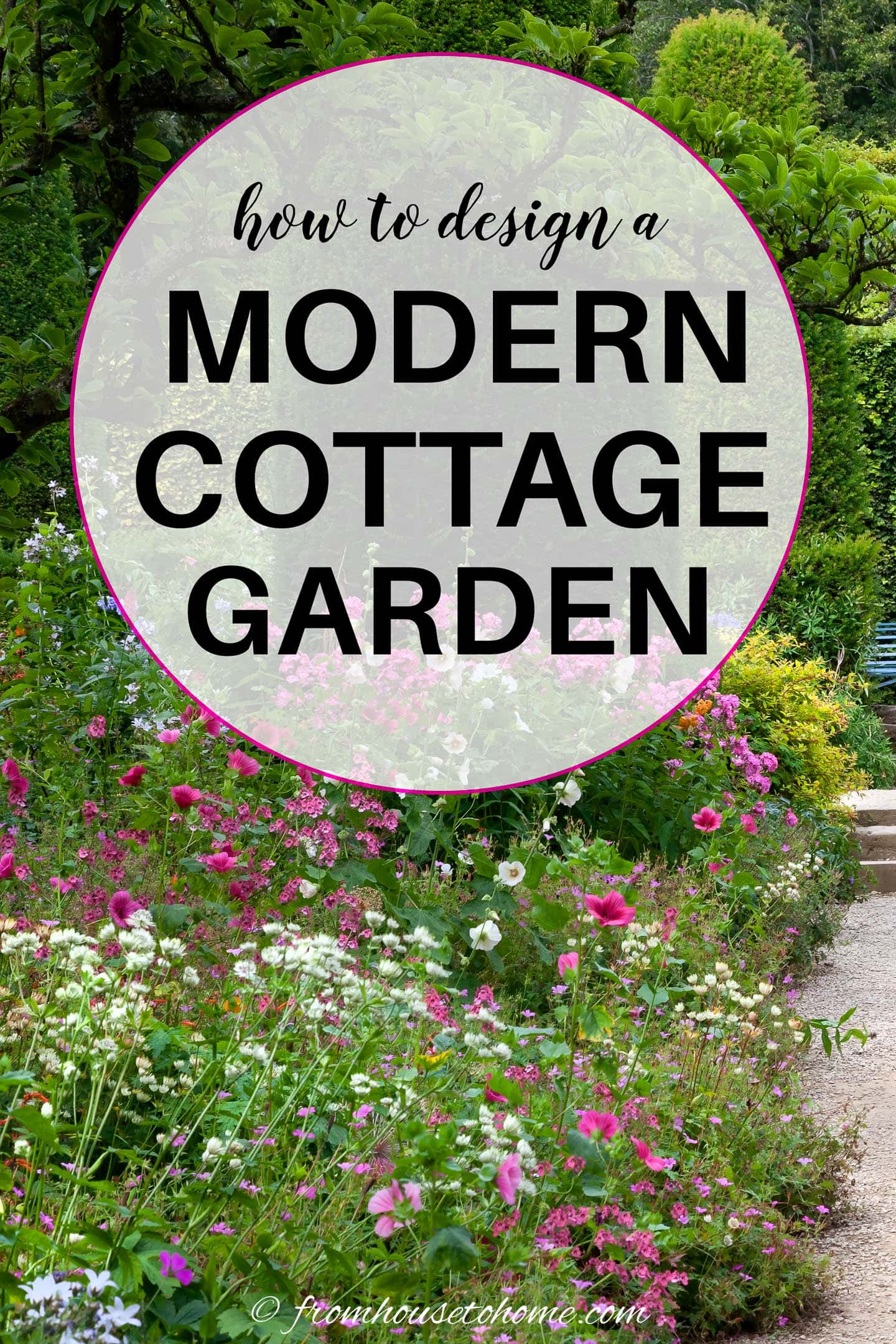
Who doesn't think with nostalgia about the casual beauty and sweet aroma of a cottage garden?
The dense planting, beautiful colors, fragrant flowers, and buzzing pollinators are a joy to behold.
And guess what? With some careful planning, you can achieve the look and effect even in a small urban setting.
The setting should be informal with south exposure being ideal for the sun loving annual, bi-annual and perennial flowers that characteristically represent the “cottage look.”
In this article I will be covering the following cottage garden design ideas:
History of the cottage garden

The English cottage garden has been around for at least two centuries.
It started out as a practical enclosed space to grow fruits and vegetables. Interestingly enough the word ‘garden' originates from the ancient Germanic peoples and means “girded” or enclosed space.
The choice of vegetables was very limited until King Charlemagne (800 AD) issued a decree that increased the types of plants grown — things like cucumbers, melons. rosemary, cumin, fennel and globe artichokes.
In the next century, the Christian monks migrated throughout Europe and cultivated gardens to sustain themselves.
They not only improved cultivation techniques and propagation methods, but they were the first people to make sophisticated garden designs.
They were gardening within the confines of the monastery walls and came up with the geometrical path system with a rose garden in the center that is still common today.
By the middle ages, around the time King Louis XIV built the formal gardens at Versailles, affluent people started growing gardens for pleasure rather than as a main source of food.
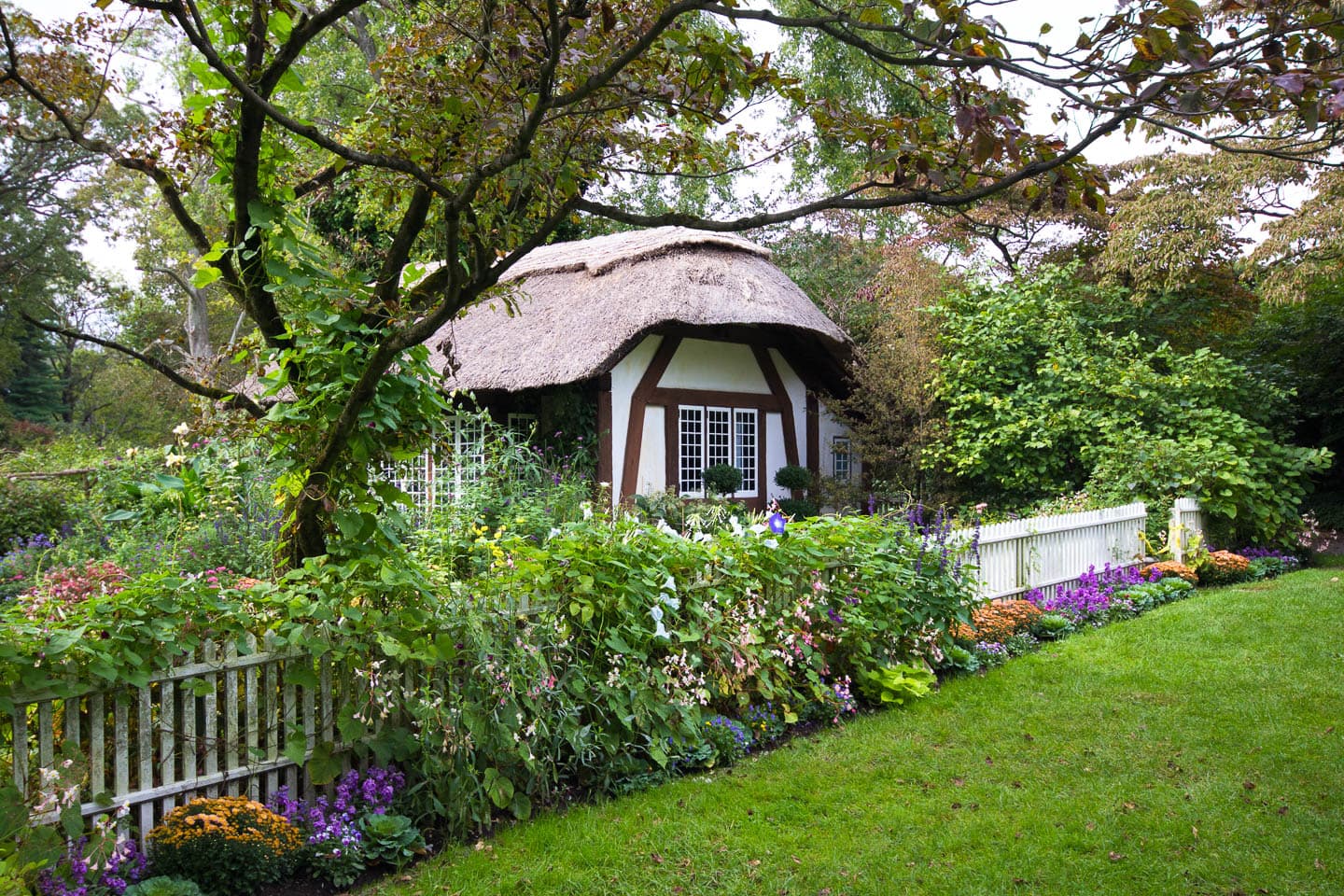
Then Gertrude Jekyll took the plantings she saw around the cottages of the British countryside and brought it to the gardens of the increasing middle class.
And so the style became known as a cottage garden.
It looked simple and natural and is remembered today more for its lush flower growth than its vegetables.
What is a modern cottage garden?

Although vegetables and fruits can be incorporated into the cottage garden, in this article I am going to be describing the modern informal urban flower garden that some would call an ‘imitation' of the ‘real' thing.
But it is what many of us picture when we think of a cottage style garden.
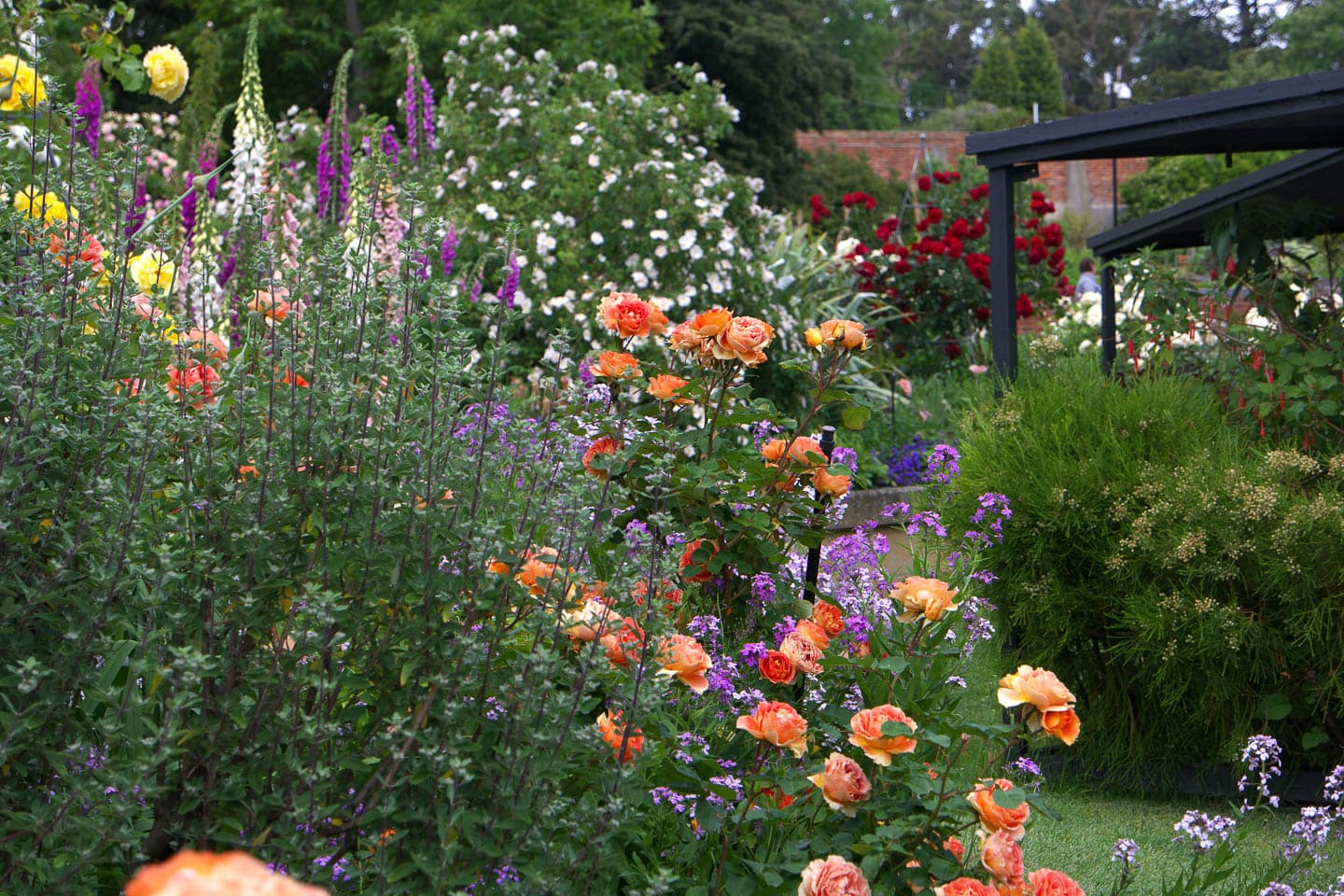
The urban flower garden is typically a small space that has little or no room for produce.
This small garden should be divided into beds joined by natural pathways.
The beds are densely planted with aromatic flowering bushes, vines, perennials, and annuals so that no soil is visible.
A cottage planting should have a profusion of flowers from spring through autumn that light up the space with coordinated colors.
Shape, size and position
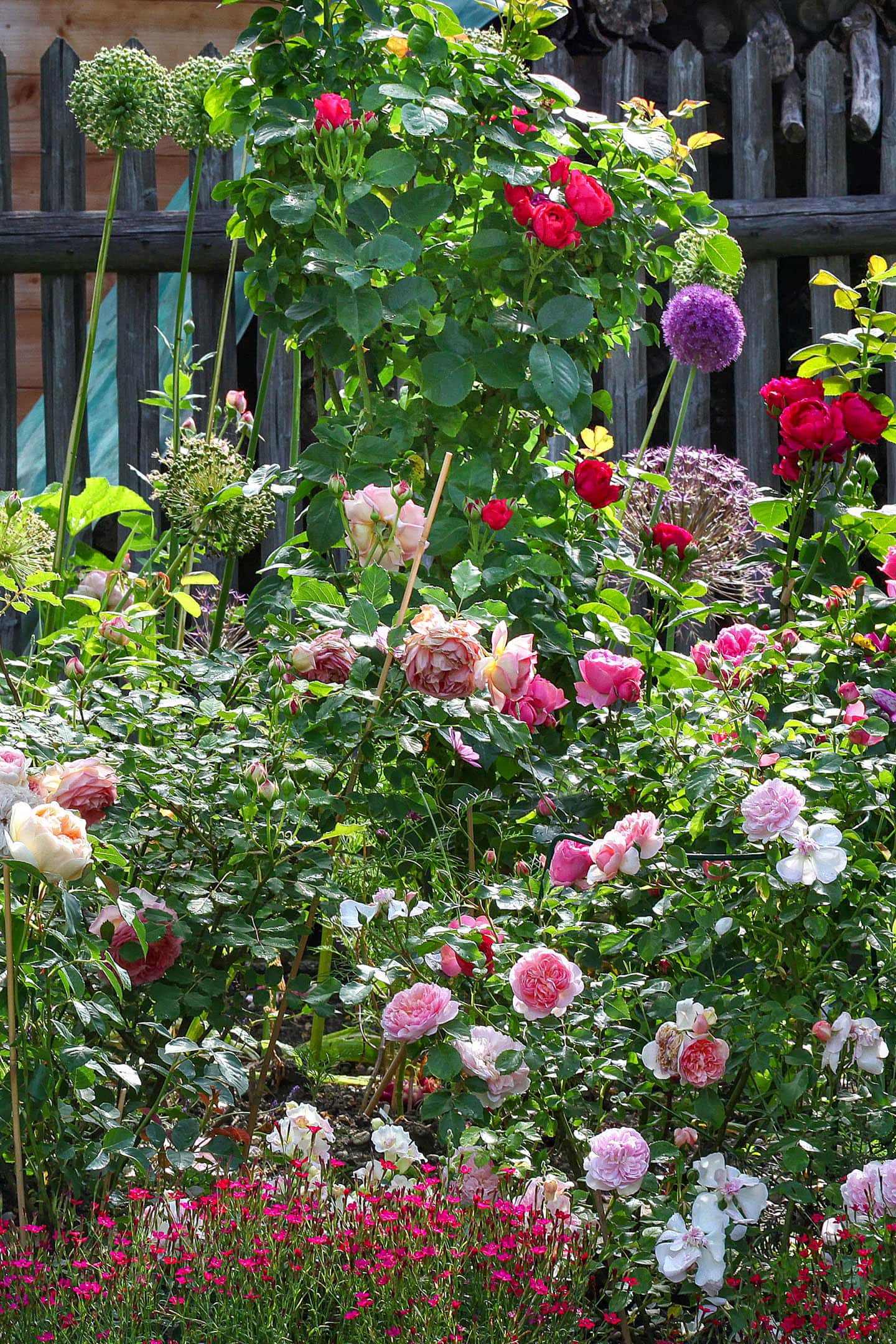
The size and shape of the urban cottage garden is often predetermined by the lot and position of the house on it.
You will need at least 30 sq. yd. to create a successful cottage look.
Ideally, the shape should be square or rectangular.
And it should be south facing. South-east or south-west would also work. Most of the old favorite flowering botannicals are sun loving.
However, since rules are meant to be broken, I have a successful cottage garden that faces north and receives many compliments.
Fences and arbors

A fence creates a visual and literal boundary to frame the entire garden.
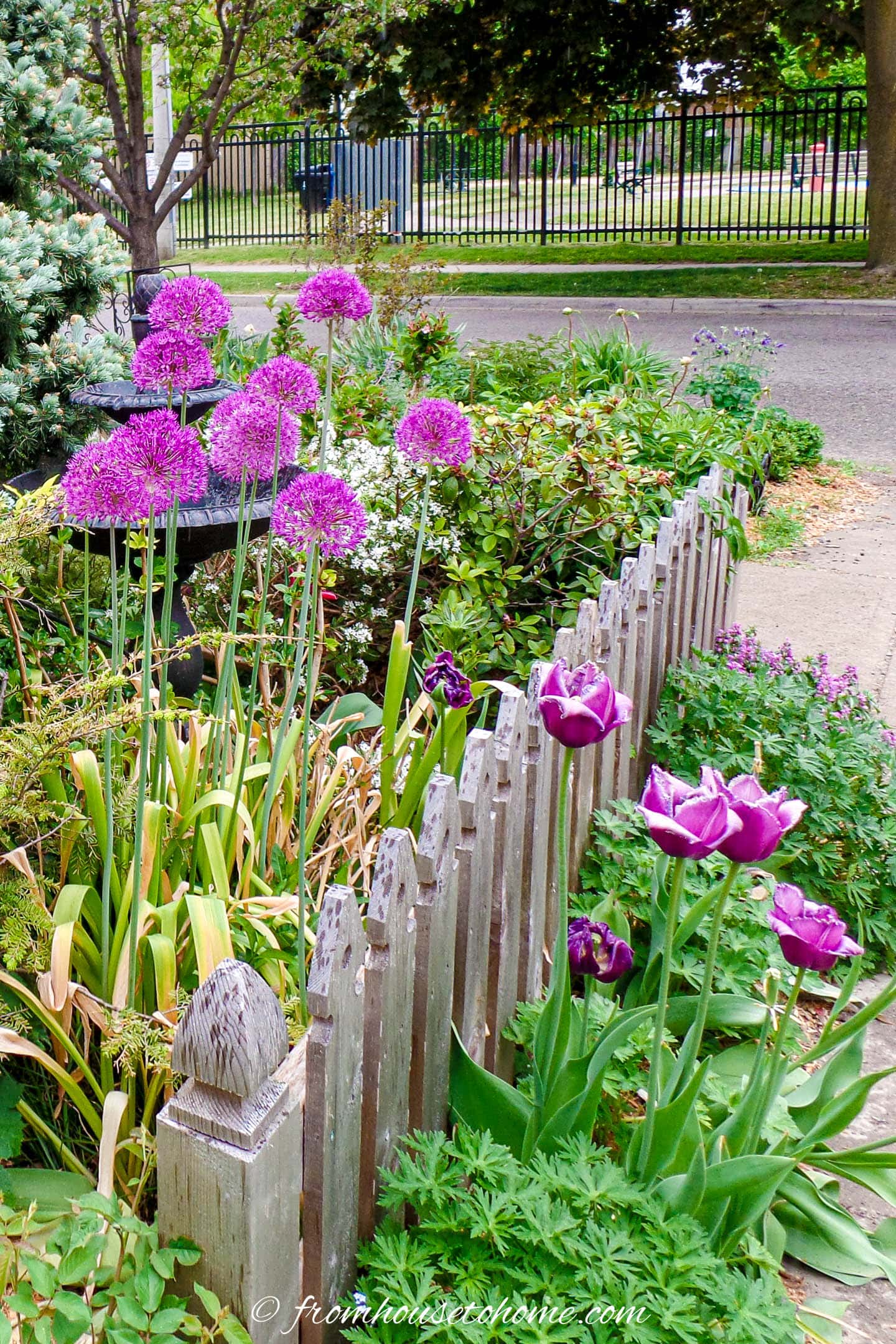
I like to place the fence about a foot from the outside edge of the garden so I can have flowers blooming on both sides of it.
That way the fence looks like it is part of the garden.
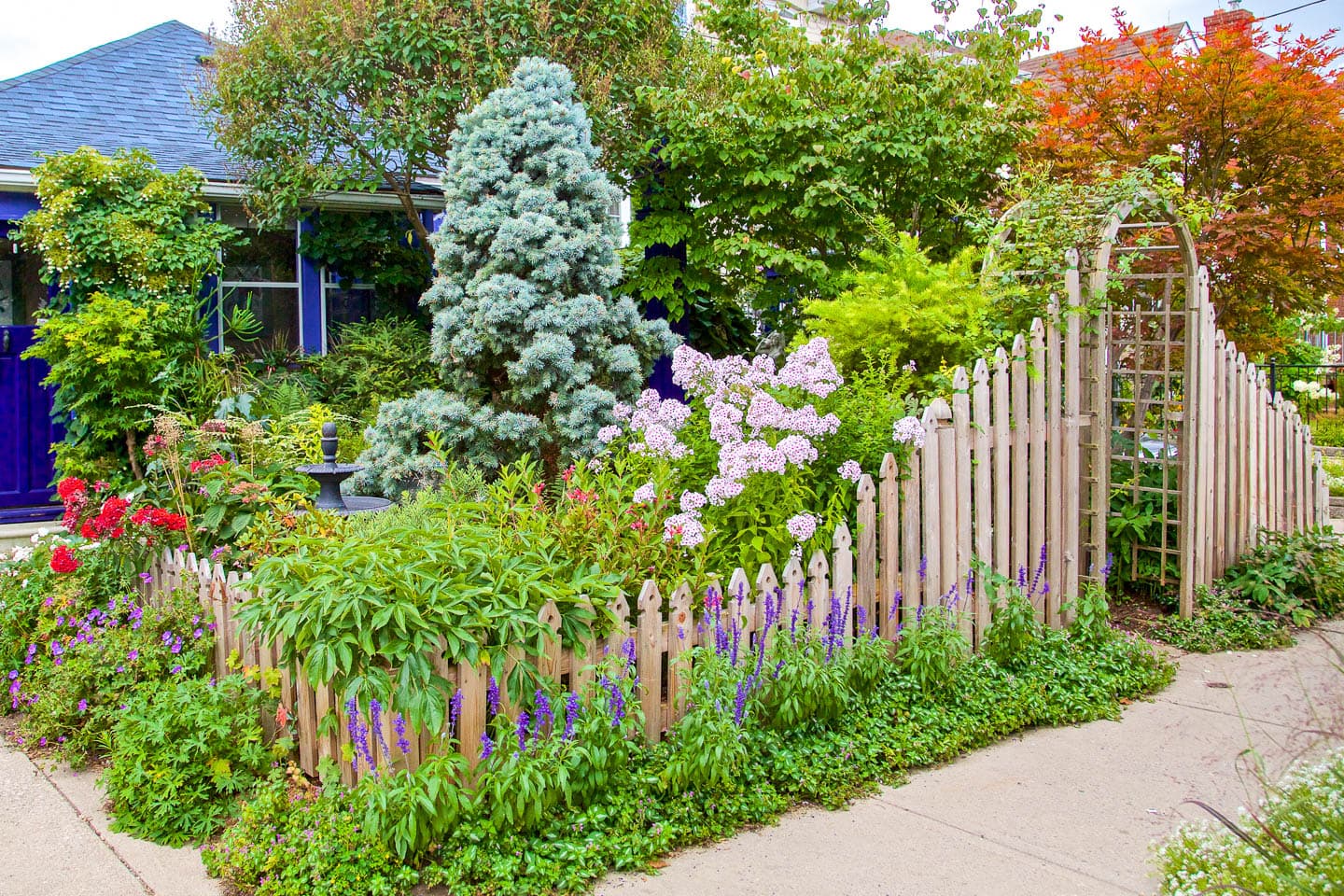
For the cottage garden look, a natural picket fence made of wood acknowledges tradition.
The fence needs to be 2 to 3 feet high. This gives visitors a good view of the flowers and plants within. A cottage garden is meant to be seen and appreciated!
Attach one end of the fence to an arbor. It acts as an inviting entry point to the main path of the garden. It also supports climbing roses and a clematis.
The arbor can be semicircular (like mine in the picture above).

Or rectangular in shape.
Both look equally stunning when covered with a multitude of blooms.
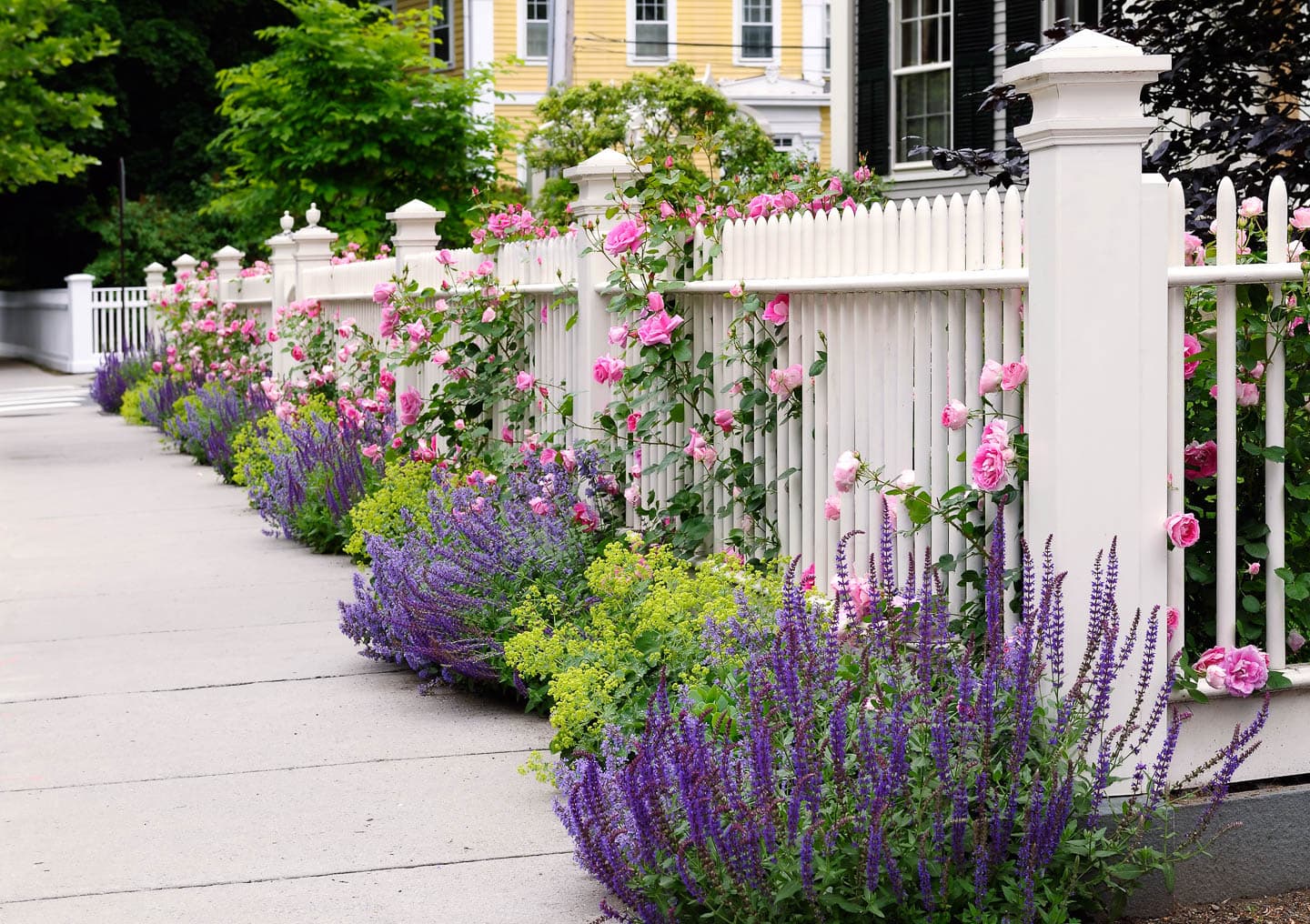
White pickets also work well. The light background really makes the flower colors pop.
Another alternative is to plant a flowering hedge.
Rose of Sharon ‘Purple Pillar' would be stunning and take up very little room.
If you have enough space, a pannicle hydrangea hedge would be lovely and bloom from early summer until fall.
Pathways and edging

Once you have the fence in place, it is time to add your paths.

Traditionally there are two paths in straight lines which dissect the space at right angles in the center.

However, I much prefer curved paths that divide the area on an angle with the arbor off center at the street end.
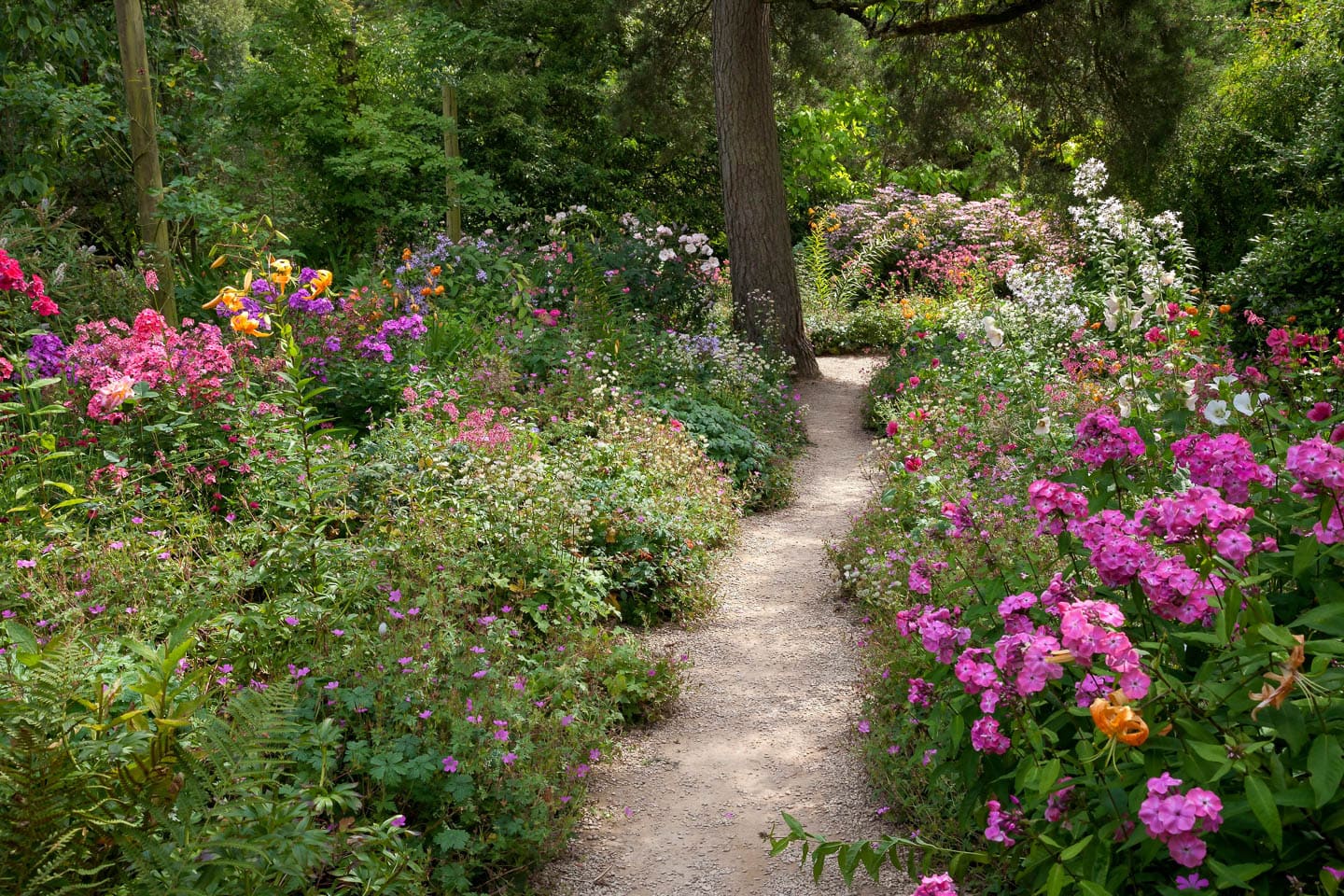
This creates some mystery as you walk through–you can't see the end from the start of the path.
If you are planning to have curved paths, you can lay out the shape using a garden hose.
The main path needs to be at least 3 feet wide. It is irritating to do maintenance with a wheelbarrow or service wagon when the path is any narrower — ask me how I know!
Materials for a cottage garden pathway should be natural.
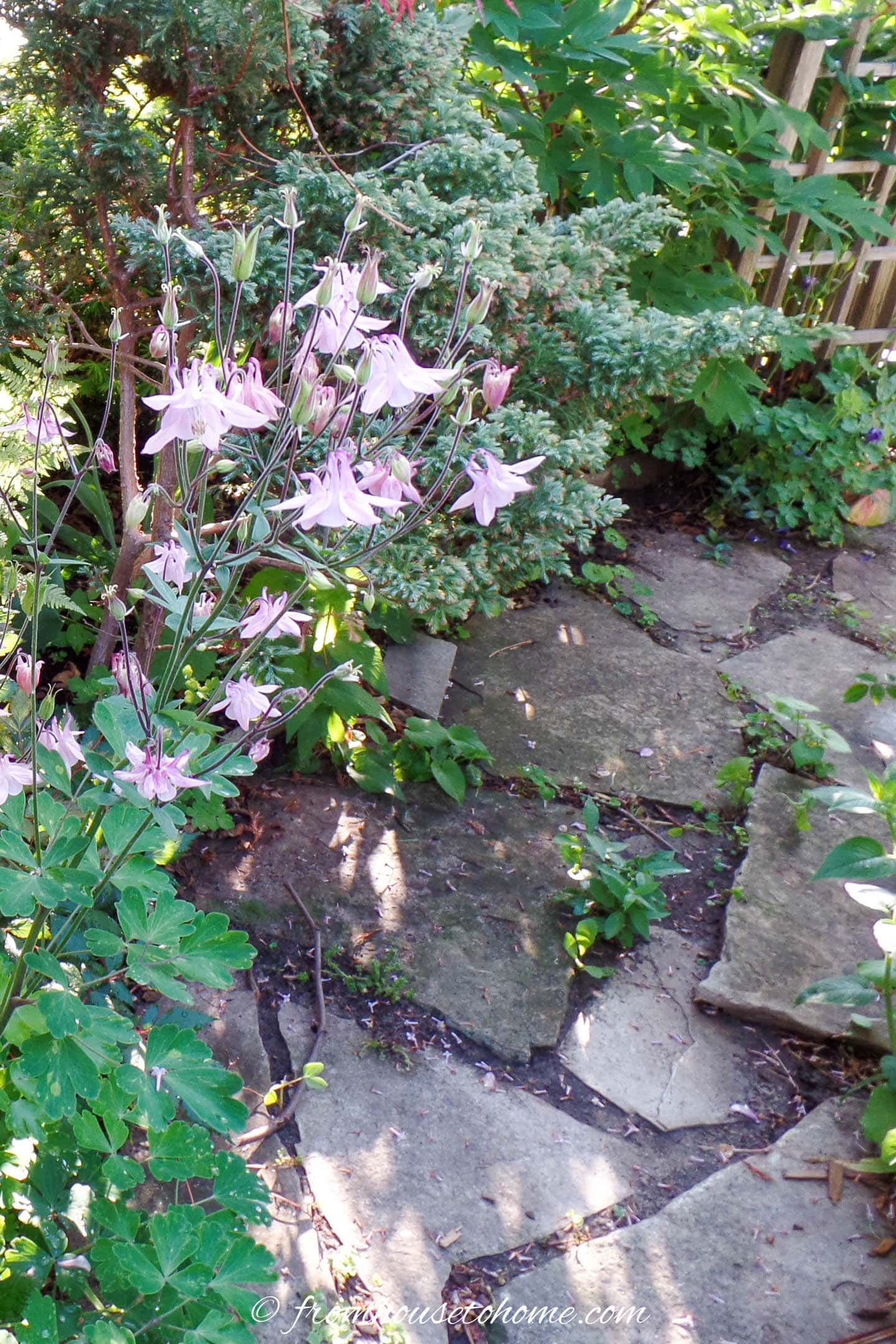
Local flag-stone set into a 4 to 8″ deep base of limestone scree and sand looks very casual and holds up well with very little maintenance. I have had mine in place for 30 years.
Other soft natural paths can consist of pea gravel, wood chips or bark mulch. The latter will need a 4-6″ gravel base and a retaining edge.
No matter the material used for the main path, it should be edged to prevent mulch and soil from spilling onto the path and vice versa, to prevent gravel going into the garden.
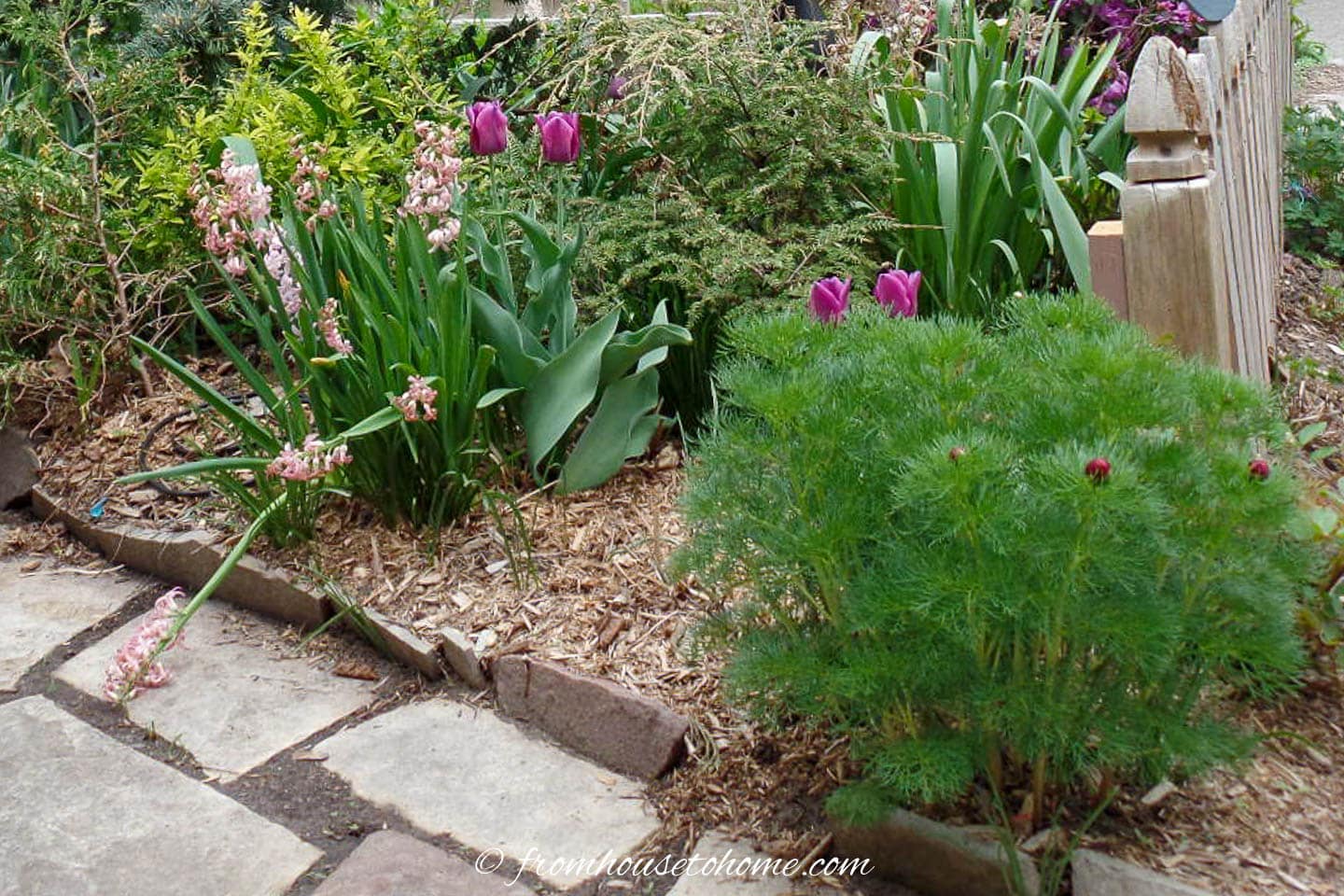
For edging, I use thin flagstones inserted upright along the sides of the path.
This is accomplished by digging a narrow trench, pushing the vertical flagstone in so that it is level with its adjoining stone, and then back-filling with mud.
Wooden edging works well with bark mulch paths. This can be pressure treated boards set on edge to outline the path. Railway logs will last a long time too.
Once you have the main path installed, you need to decide the size of each bed. If you want to be able to reach all areas of a garden bed easily, it should be no wider that 4 feet.
The shape of the beds can be outlined using a string or hose.
Plan to have narrower side paths that feed off of the main one to allow access to the areas you cannot reach. Flagstone stepping stones on a bed of mulch work well for these secondary paths.
Find more ideas, see these garden path ideas.
Now the beds are ready for your favorite blooms!
Cottage garden plants

Although the cottage garden's profusion of plants may look like they have seeded at random, careful planning is behind the haphazard effect.
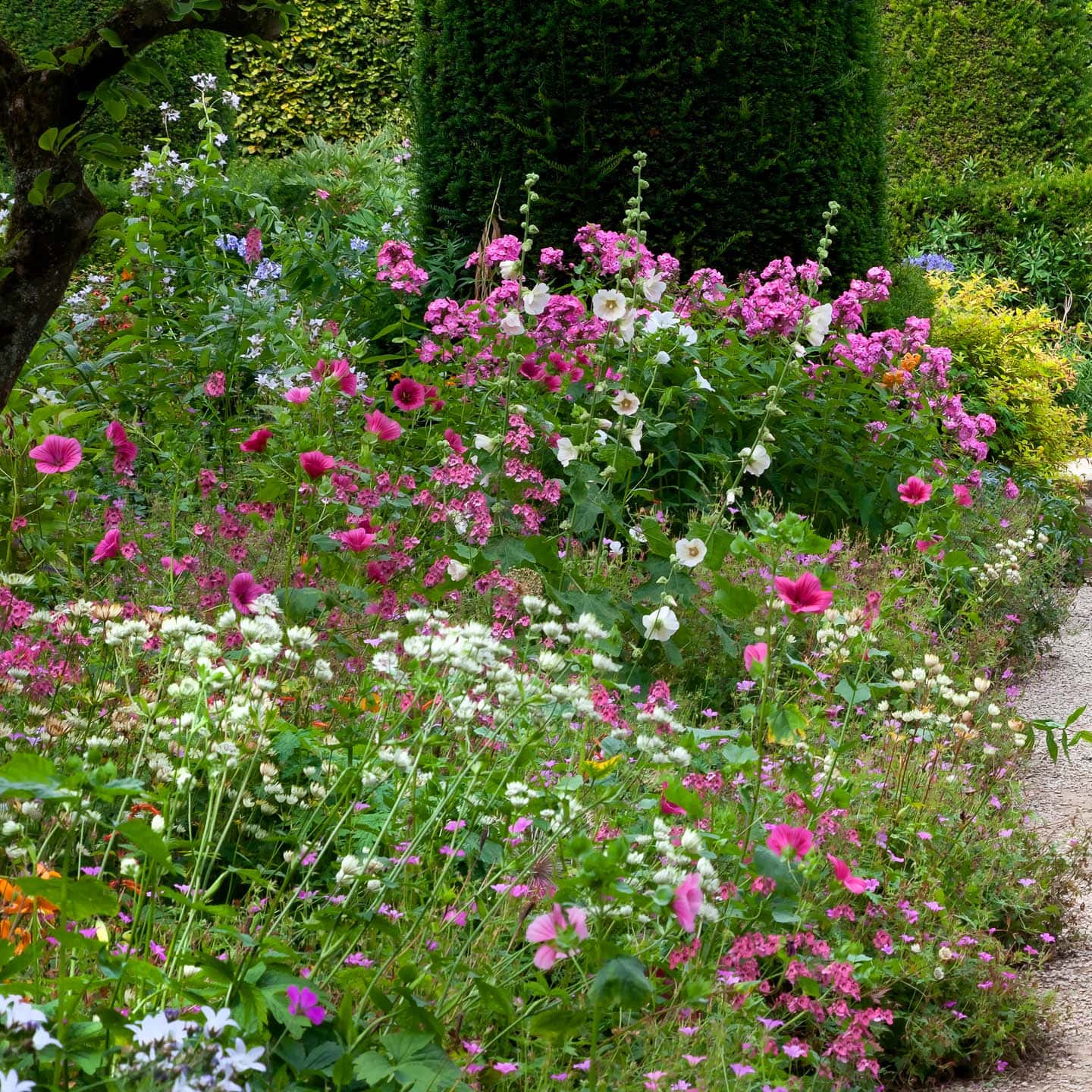
Here are a few tips:
- Before you start planting, amend the soil with well rotted cow or rabbit manure, compost, and/or triple mix. Dig it in well. All those blooms need lots of nutrients to keep them going.
- Try to choose as many aromatic plants as possible.
- Aim for all season interest.
- The plants need to have a variety of heights ranging from tall to short.
- Of course, select your favorite colors while keeping in mind you want harmony and serenity rather than garish.
- Buy multiples of the same plant in odd numbers, e.g. 3, 5, or 7, rather than singles unless it is a statement bush. Repeating each species of plant several times throughout the garden draws one's eyes around the garden.
- Another important consideration is the inclusion of plants with different growing heights. Specimen shrubs like lilac, forsythia, pillar hibiscus or panicle hydrangea and perennial delphiniums with biennial hollyhocks and foxgloves help to give the garden an important three-dimensional effect.
Roses
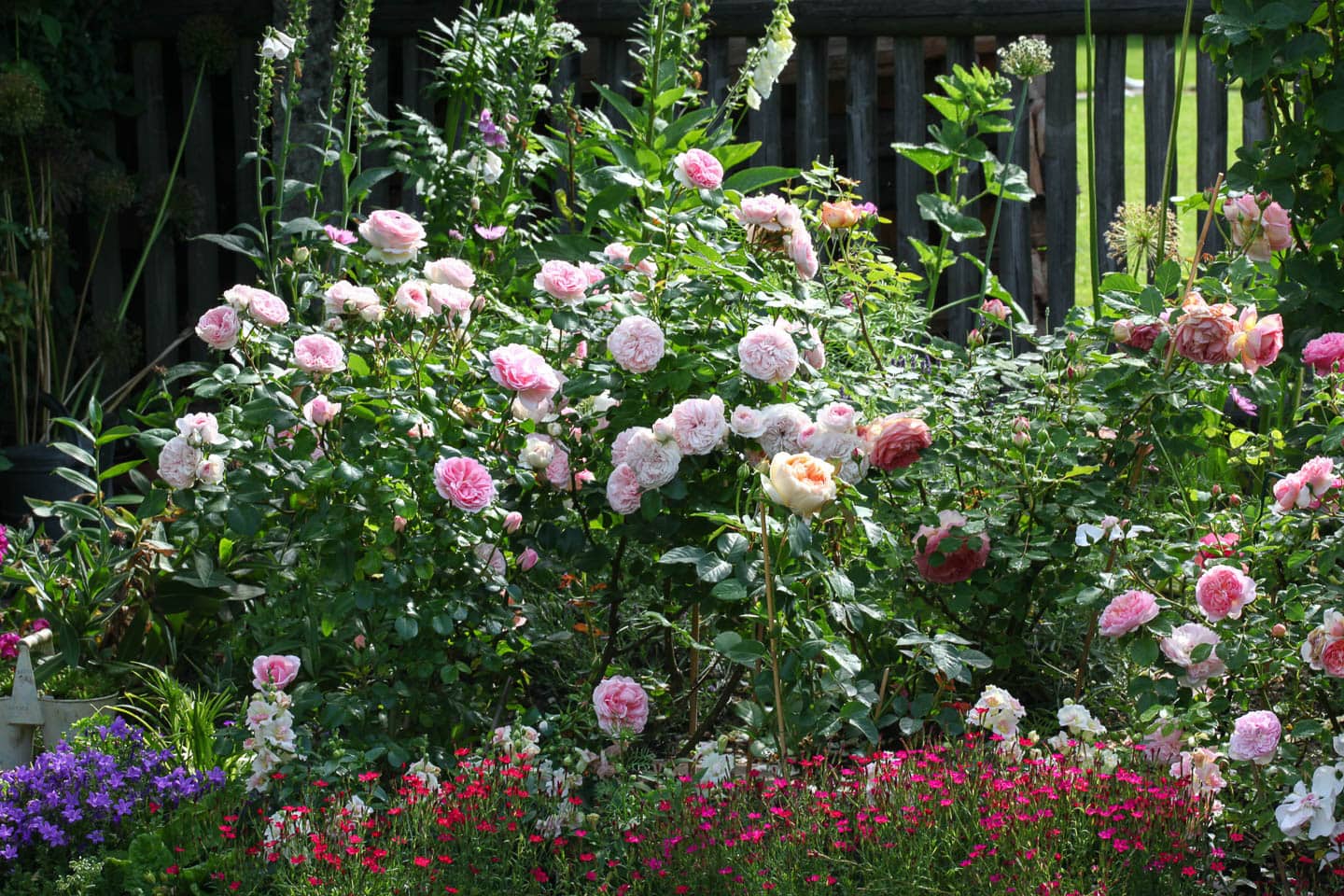
One of the most important plants in the cottage garden are roses.
You want climbers, disease resistant shrub roses, old fashioned David Austin English roses, miniatures and even standards.
What you don't want are hybrid teas. They require a lot more maintenance and tend to get diseased when crowded with other plants.
Combine roses with lavender for a pleasing aphid free combination.
Bushes and small trees
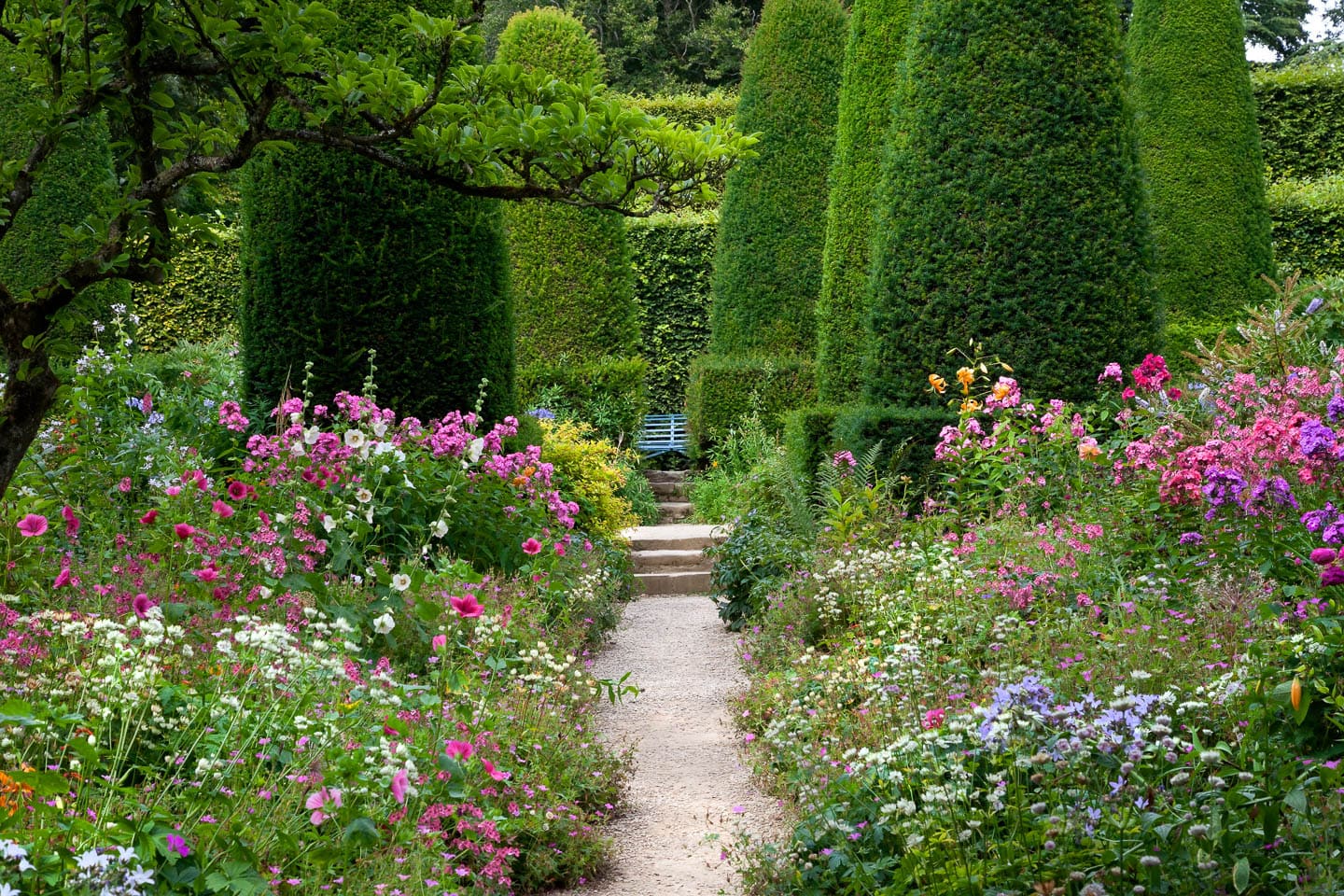
Other bushes to consider are lilacs, forsythia, weigela, peony, hydrangea, spirea, viburnum, hibiscus, mock orange, and/or deutzia.
I also like evergreens used in moderation, for their textural contrast and winter interest.
A neatly trimmed single species flowering hedge can provide a nice backdrop to the flowers.
Small trees like dogwood, black lace elderberry or fruit trees are fun.
But it's a good idea to avoid large trees and conifers that take up too much space and provide too much shade.
Read about our favorite cottage garden shrubs.
Perennials, biennials and annuals
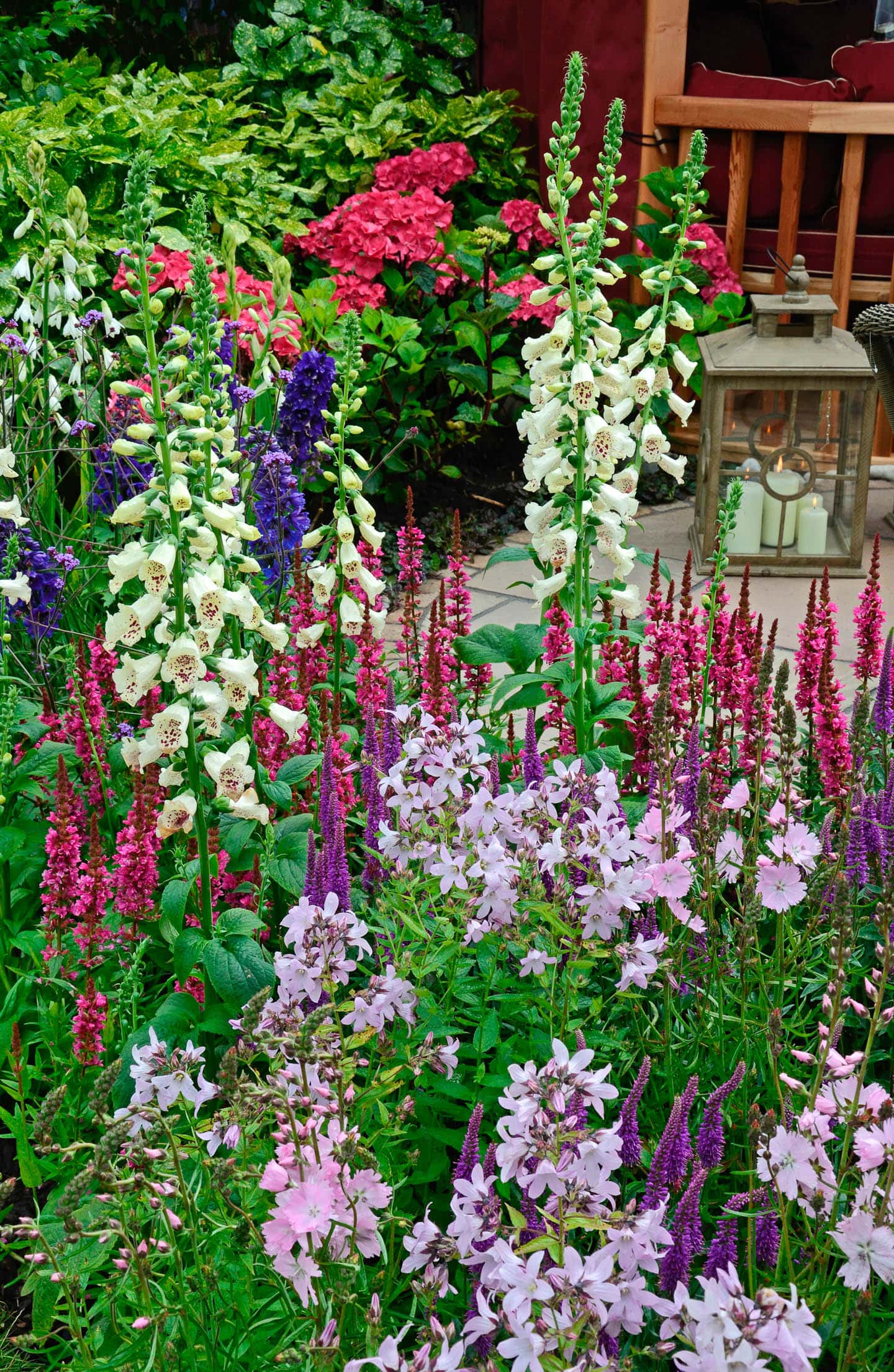
Whereas the bushes anchor the beds, the perennials, biennials and annuals are the main show.
Pay attention to the heights these are supposed to attain because they should generally be planted with the tallest at the back of the bed and graduated down to the shortest along the edging of the paths. (But be careful not to be too regimented with this or you'll lose the informal cottage garden look).
Hollyhocks, delphiniums, cosmos, and helianthuses are back of the border plants.
In front of them, try phlox, echinacea, poppies, scabiosa, daisies, foxgloves, lupins, columbines, salvia, aster, chrysanthemums, bergamot, bleeding heart and yarrow to name a few.
Plants for the edge of the pathway include marigolds, petunias, cranesbill, alyssums, pelargoniums, and heuchera.
Read about our favorite cottage garden perennials and biennials.
Climbers
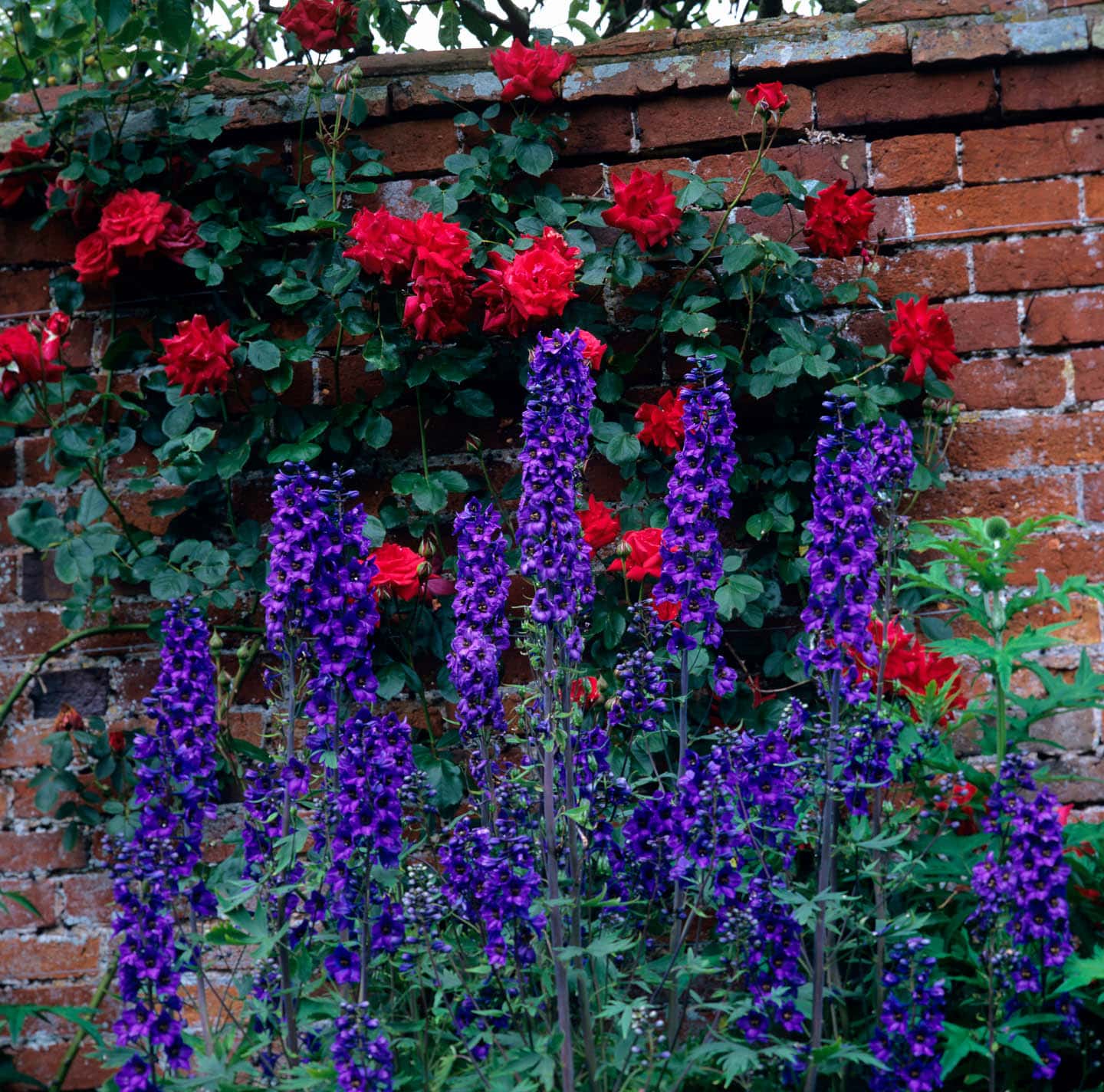
Every cottage garden needs climbing plants to cover walls and arbors.
As well as roses, clematis is another good choice. Both need an arbor or a trellis to climb on.
Other climbers like Japanese honeysuckle and wisteria are pretty but too invasive, and will require a lot of maintenance to keep them from taking over the garden.
If you have shade, like I do on the front of the house, climbing hydrangea has pretty white flowers.
Bulbs
Bulbs have an important role in the cottage garden.
Crocus and snow drops start the blooming season, followed by snowflakes and grape hyacinths.
Then come the tulips, the gorgeous scent of hyacinths, and the glory of daffodils.
Bell-shaped fritillary and globe allium add their magic until the Madonna lily bursts forth in June.
In summer gladioli add a contrast in form, followed by dahlias.
All contribute to the beauty of the cottage garden look.
Color combinations to try
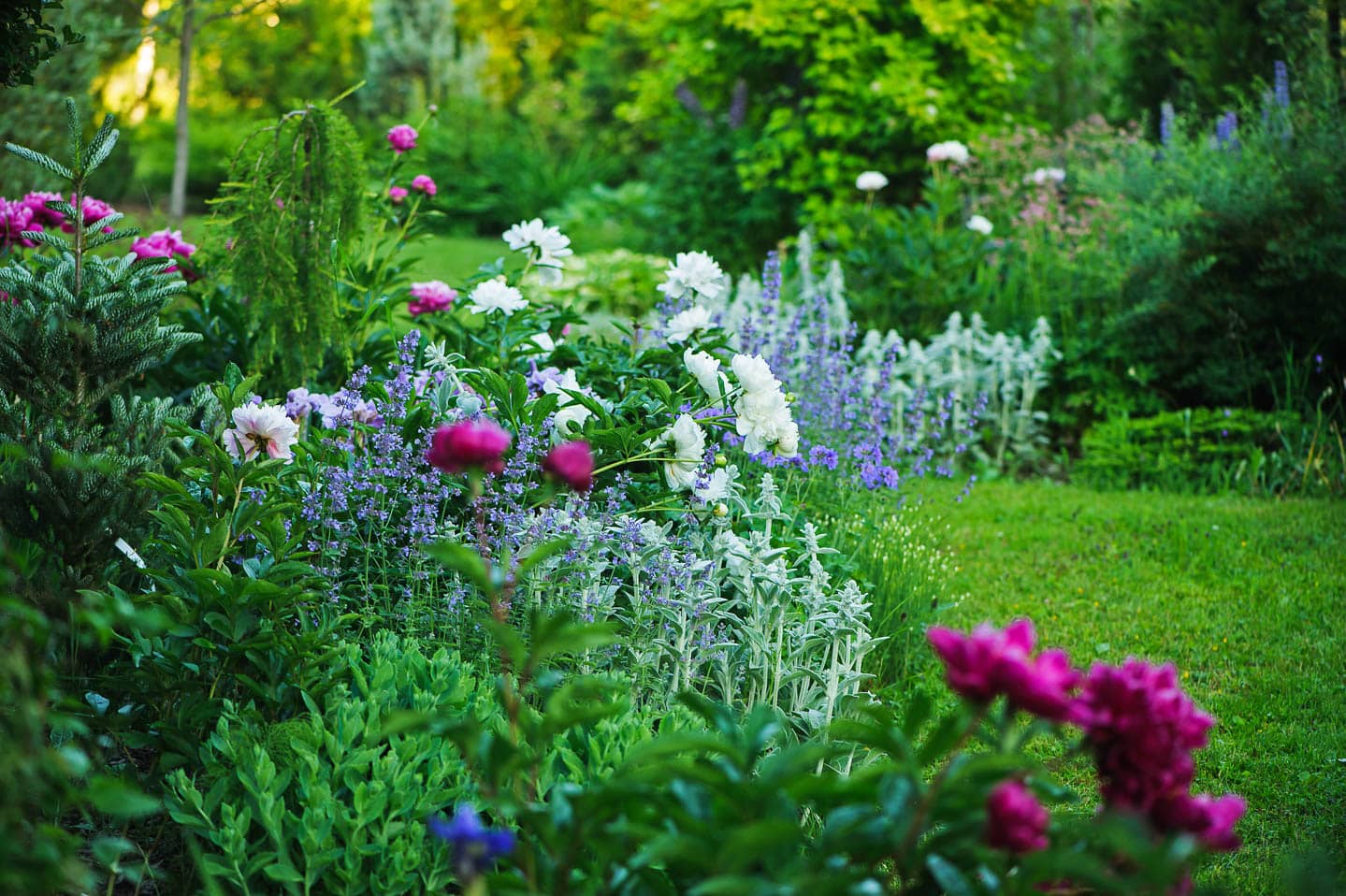
Suggestions for a blue, pink and white combination could be lilac, or mock orange, roses, hydrangea, clematis, delphinium, Echinacea, globe thistle, foxglove, Madonna lily, phlox, Shasta daisies, aster, Salvia, Cranesbill and Alyssums.
If you prefer yellows, try tall marigolds, yarrow, Helianthus, Margarita daisy, chrysanthemum, evening primrose, French marigolds or Heuchera with Forsythia, ‘At last' landscape rose, and a yellow climbing rose.
To learn more, read how to create plant color combinations.
Accessories
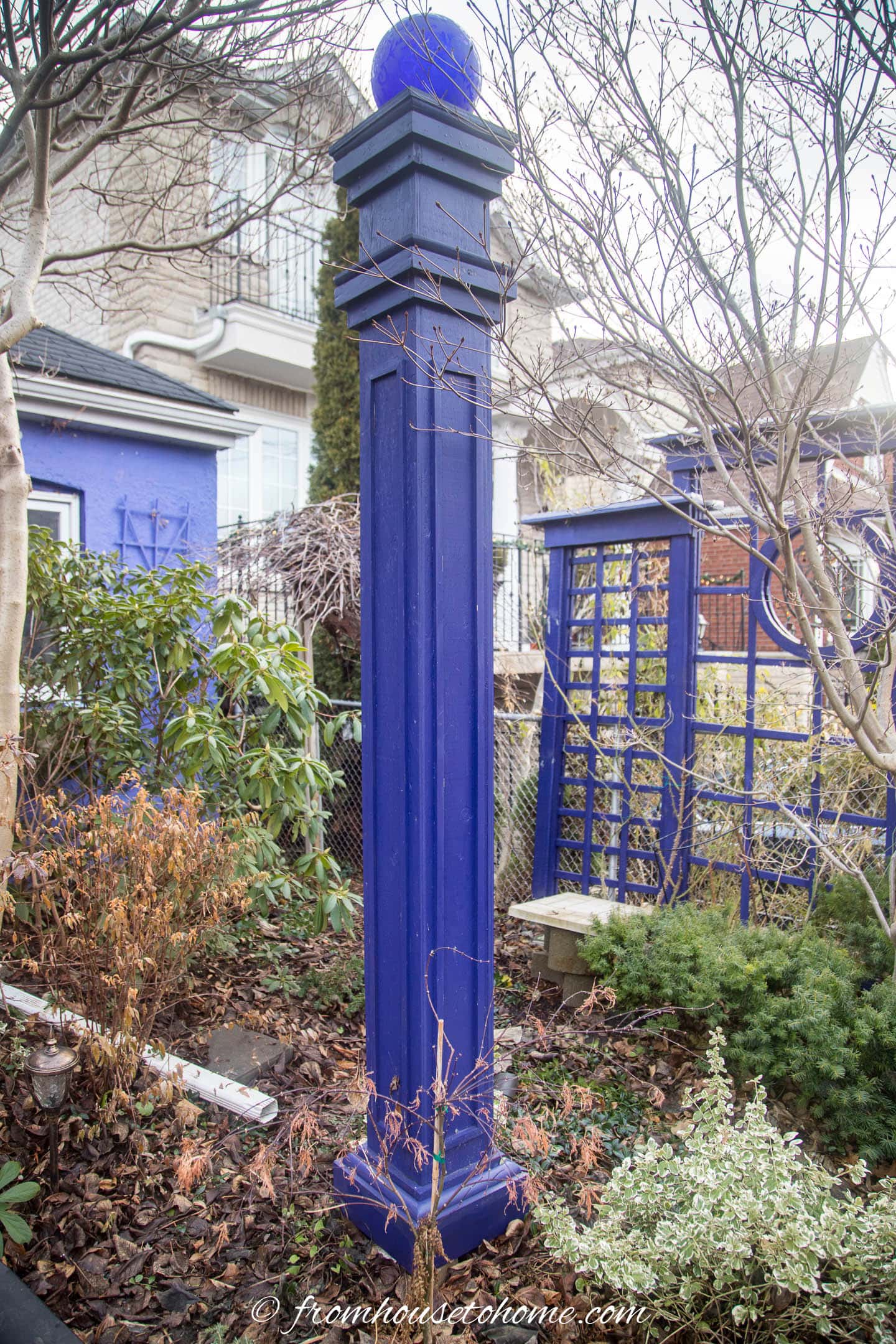
Besides the fence and arbor, your cottage garden can contain simple accessories made of wood or ceramics. Formal cement statues are out of place here.
A gazing globe on a pedestal reflects the light and the blossoms and adds an interesting perspective in the garden.
Water Feature
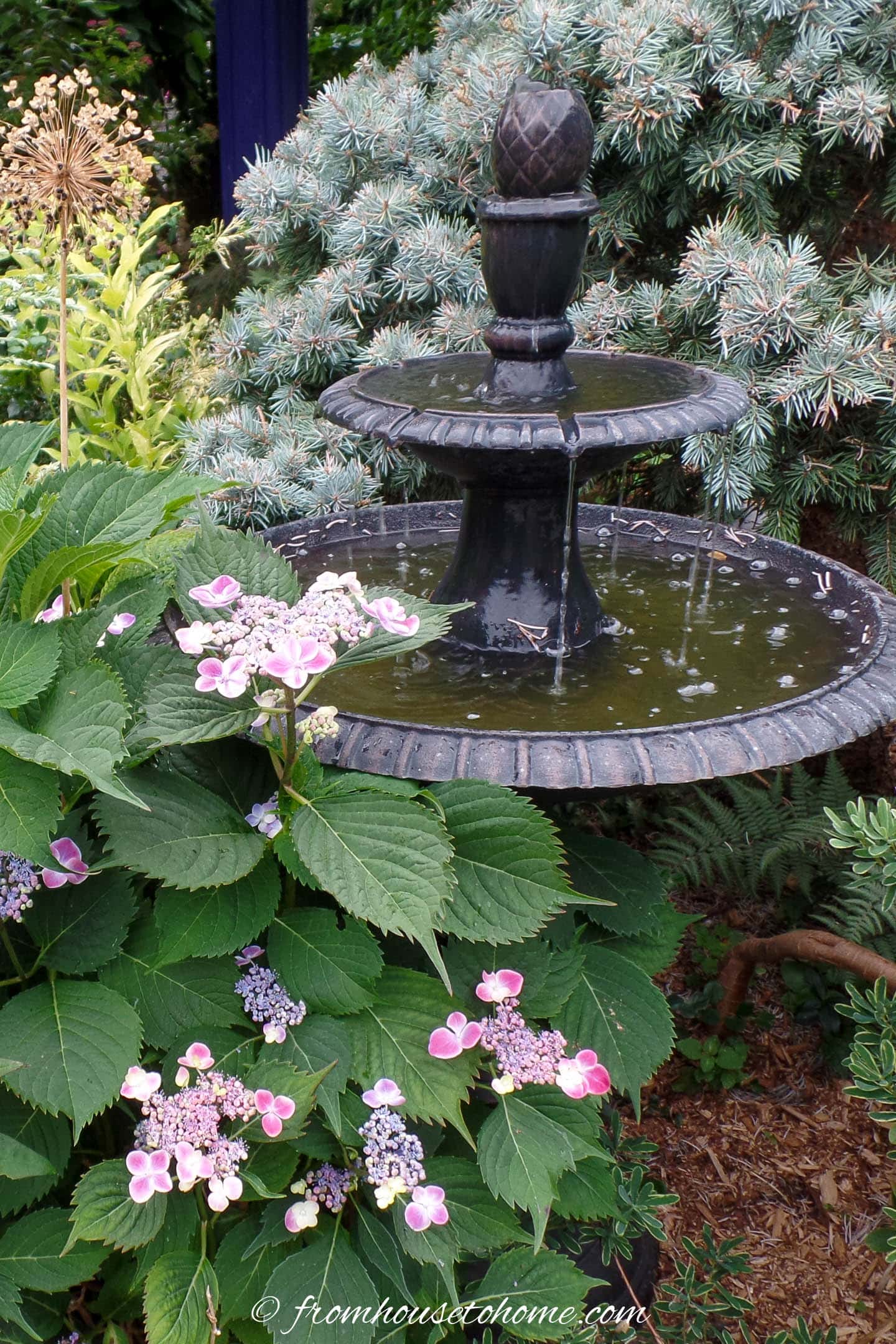
It is important to introduce water into the garden to provide a place for birds to hydrate and to have the soothing gurgling sounds.
A water filled wooden half barrel containing a small aerating pump provides a traditional water interest.
However, any fountain that water is pumped through will achieve the auditory and visual effects you want, especially if it is surrounded by blooming plants.
Find more water feature ideas.
Planters

Strategically placed decorative pots filled with a profusion of flowers and colorful foliage also enhance the surroundings.
Place them around the front door to draw the eye there, as well as around other destination places like a bench.

I like to use blue pots to make the colors stand out. (Although after the plants have grown, you can barely see the containers).

Blooming containers can be put on pedestals among the garden flowers, or at a junction in the pathway as focal points.
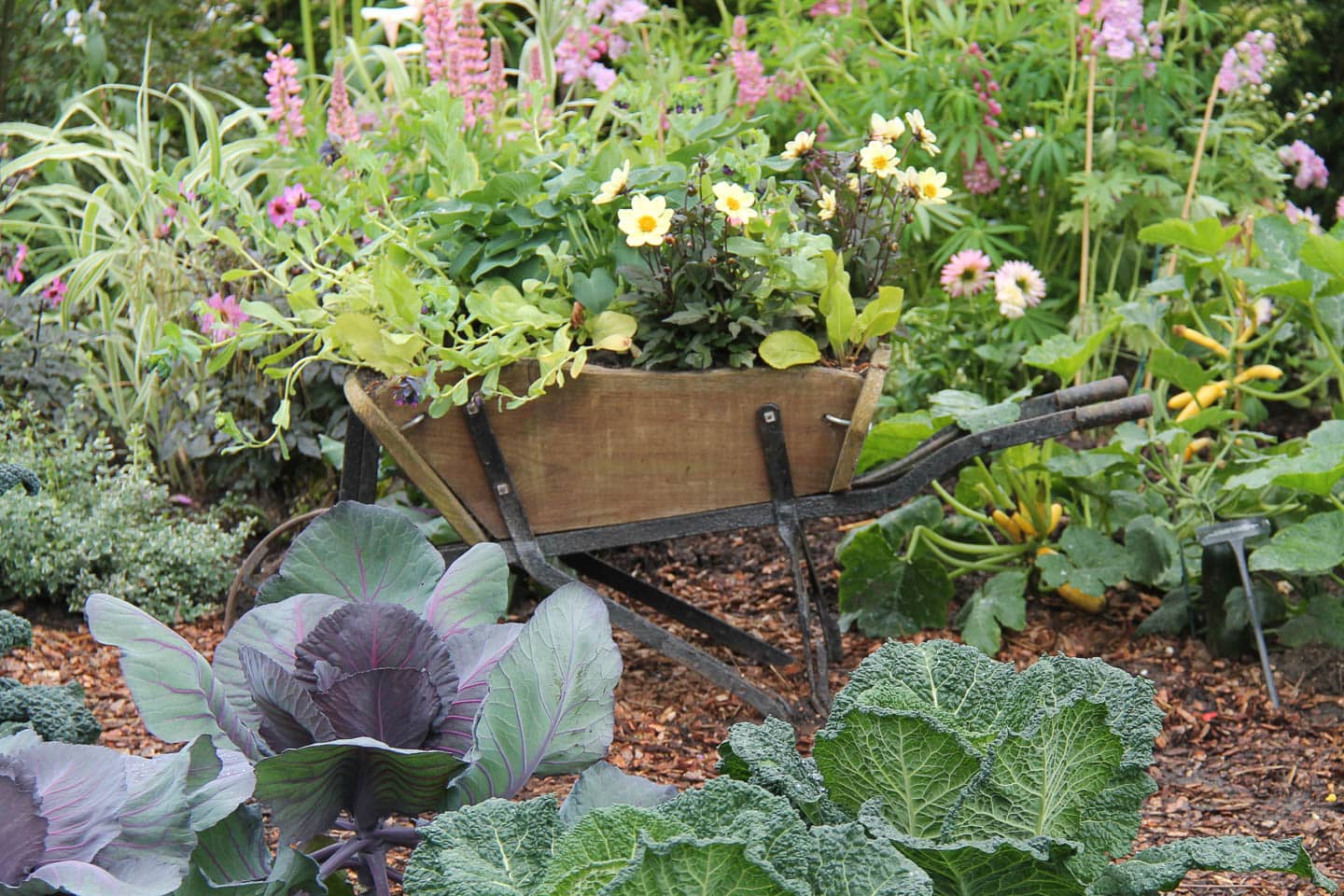
An antique wooden wheelbarrow overflowing with pots of blooms is another traditional accessory that adds ambience to the cottage garden.
If you cannot find such a barrow, use an old wooden chair to hold a container of flowers in a strategic spot in the garden.

Wooden window boxes overflowing with blossoms on the window ledges help to unite the house with the garden.
The colors in the boxes should accent or harmonize with the flowers in the garden (and in my case, the purple house).
Get more container ideas.
Benches

Most importantly, provide a destination or place to sit and contemplate the beauty and peace of your surroundings.
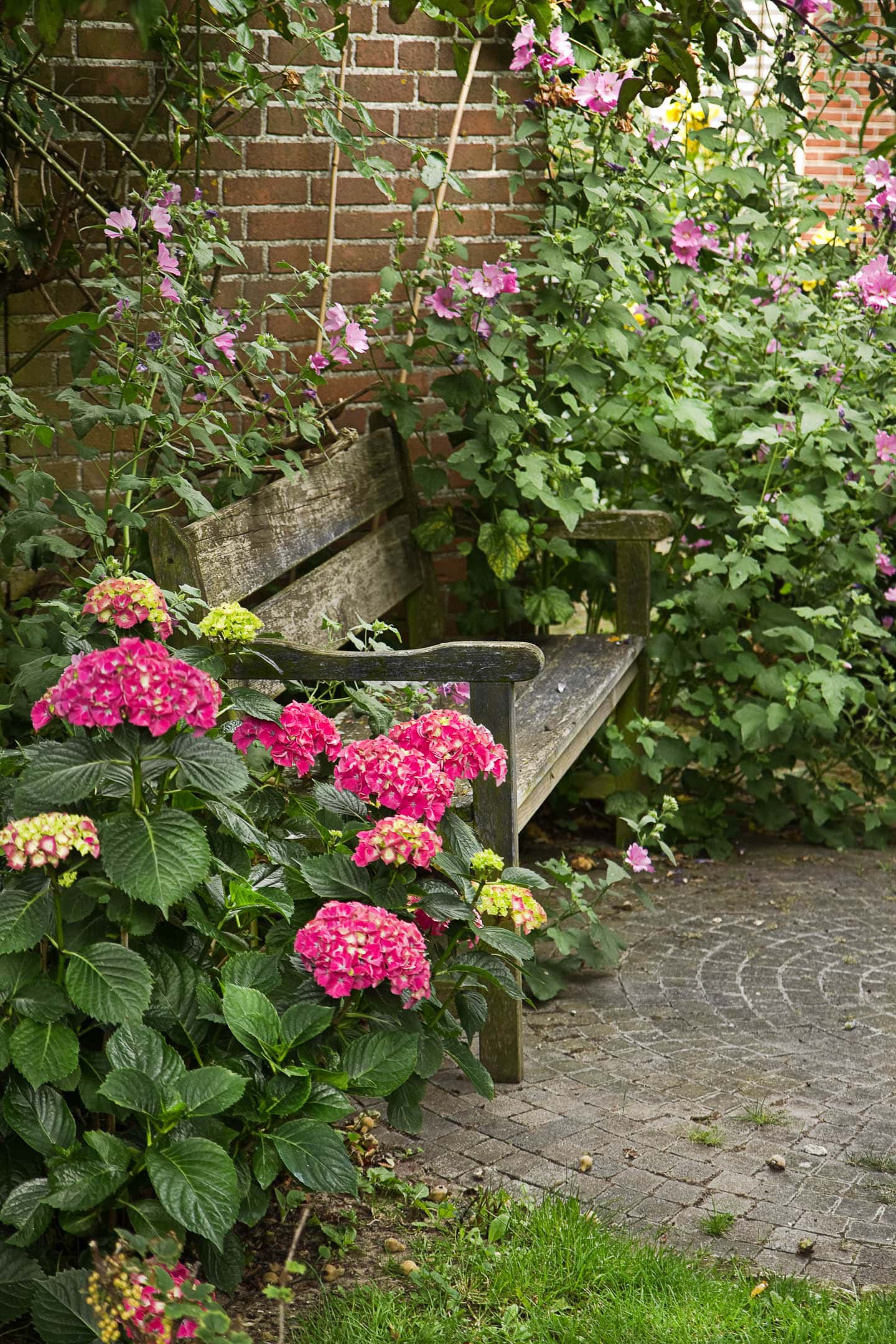
A metal or wooden bench, a glider, or a half gazebo will facilitate reflection, relaxation, and a feeling of well-being.
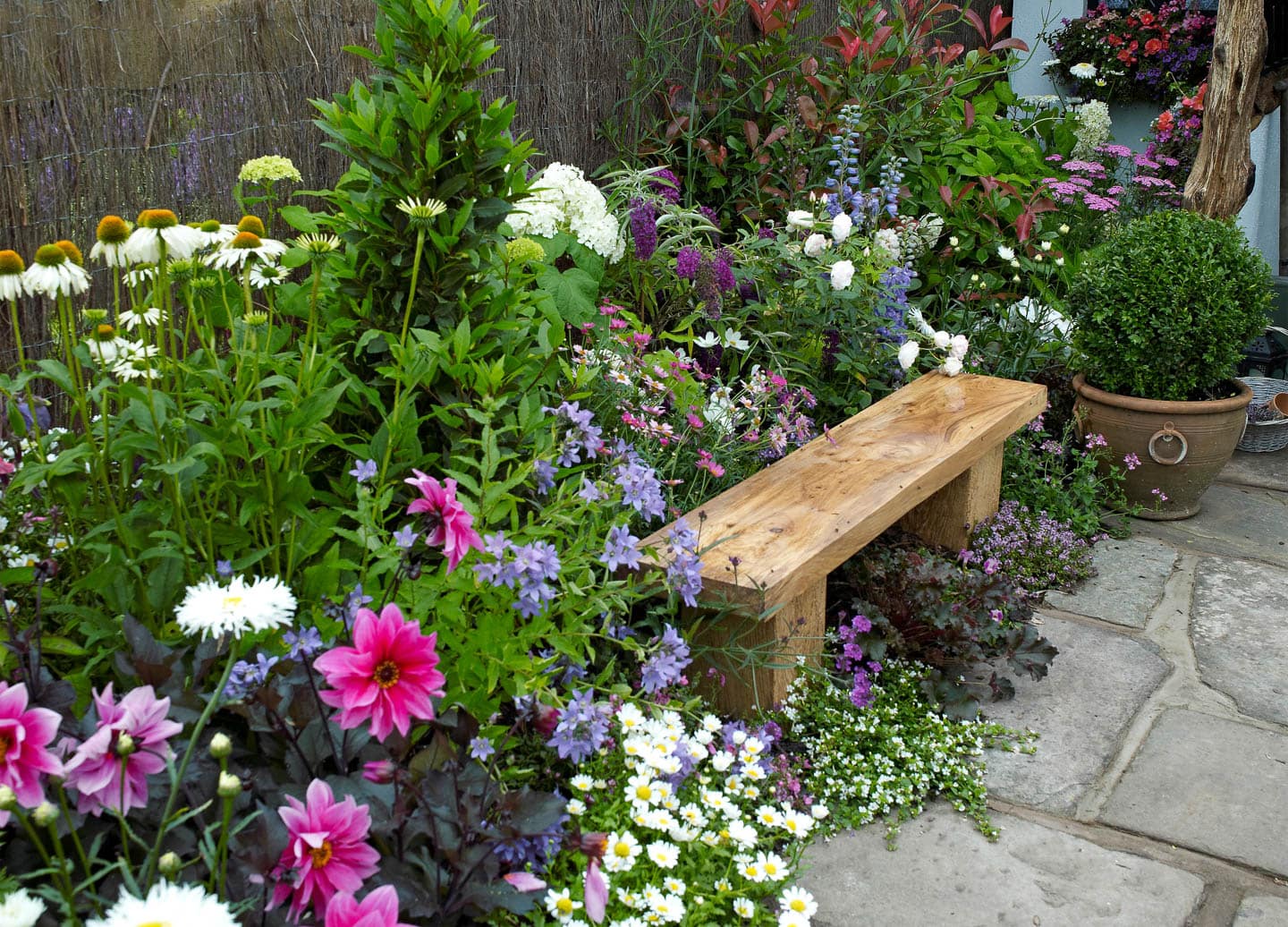
Even a small cottage garden border has enough room for a narrow bench like this one.

Try to plant some beautifully scented flowers nearby so you can smell them while you are resting.

If you want to make it more of a focal point, try painting the bench blue.
It's a color that's not found often in flowers so it will provide contrast that makes both the bench and the flowers pop.
Maintenance

It is only possible to enjoy the serenity provided by the lushness of the cottage garden if it is well maintained.
I always put down an annual spring application of 1 to 2 inches of well-rotted animal manure to ensure that the plants thrive.
After the manure is down, follow with 2 to 3″ of mulch. I use natural cedar mulch for this.
This will help the soil retain moisture and will also help to discourage weeds.
Weeds will also be kept at bay by the denseness of the plantings.
However, if you want an impressive cottage garden it is imperative to make sure you pull weeds and quack-grasses regularly. I think more cottage gardens are unsuccessful by neglecting this one task than any other factor.
Water regularly during dry spells, deadhead, and stake plants as necessary to keep the flowers looking attractive all season.
Then take some time to enjoy the sight of butterflies, birds and bees attracted to this beautiful space by the intoxicating aromas and lovely blend of colors.
Other garden ideas you might like
Cottage garden ideas:
Garden design ideas:
Have comments or questions about our small cottage garden design ideas? Tell us in the section below.
Pin It So You Don't Forget It!
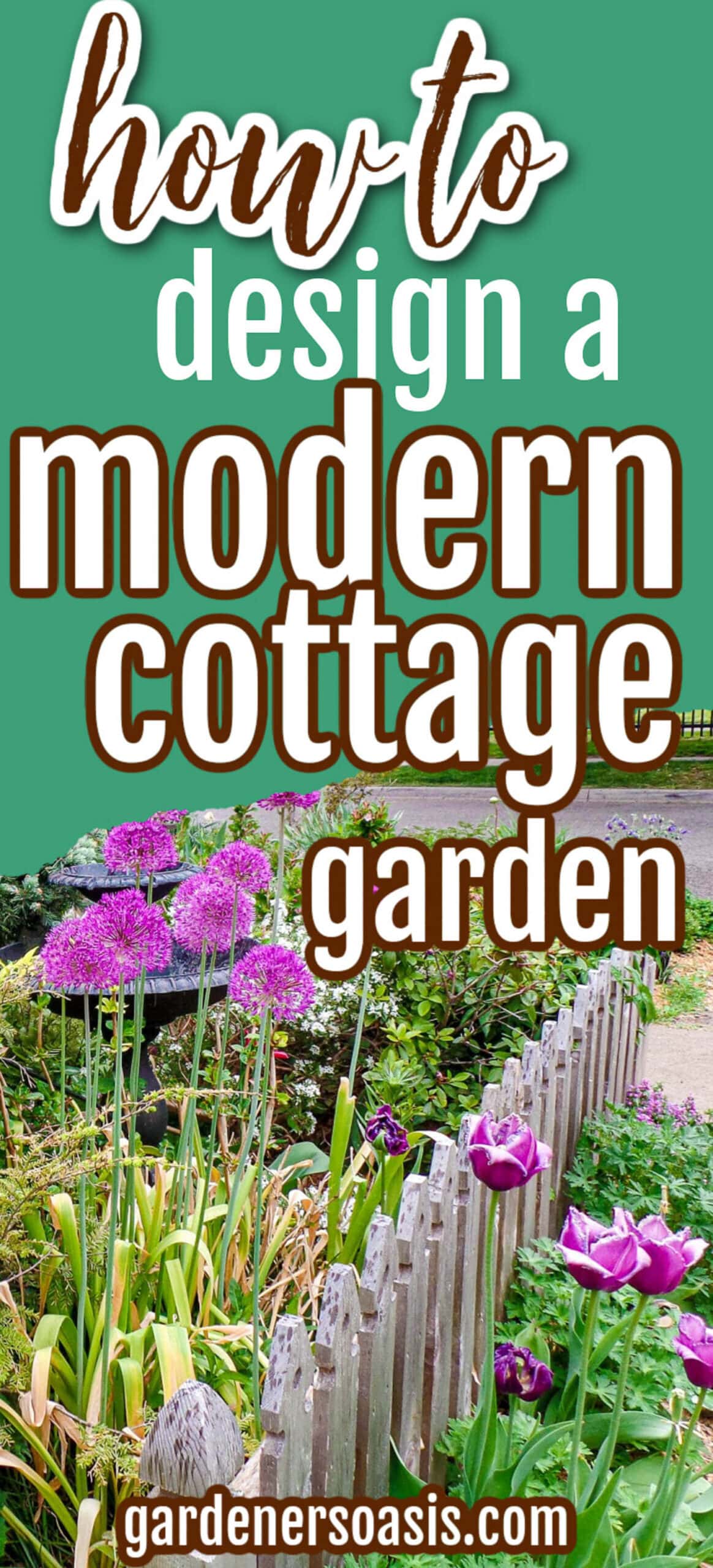
This post was originally published on February 11, 2022 but was updated with new content on December 7, 2024.

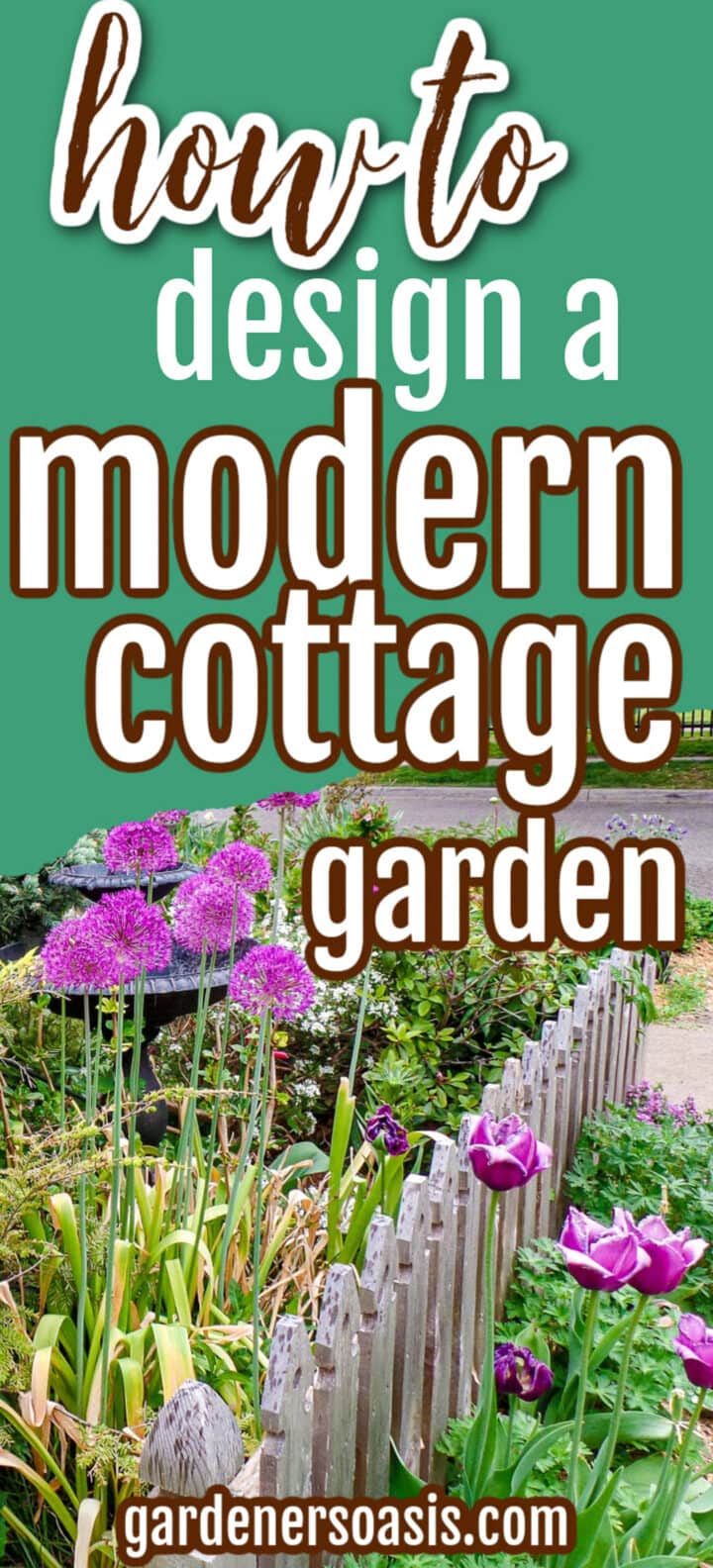
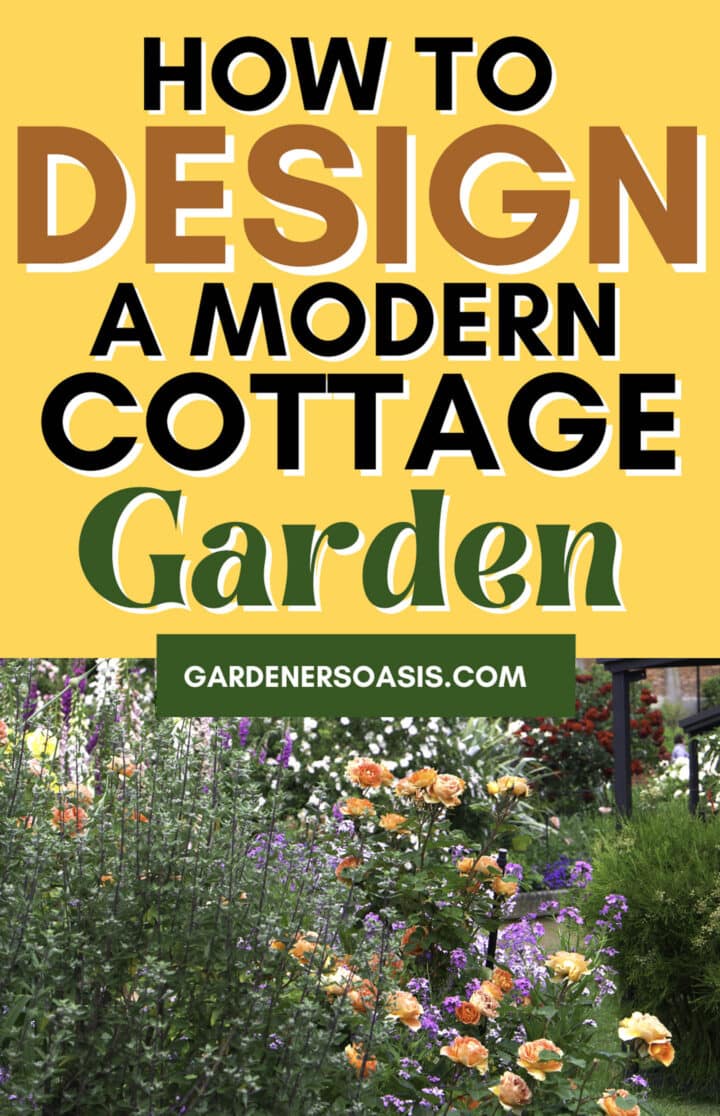
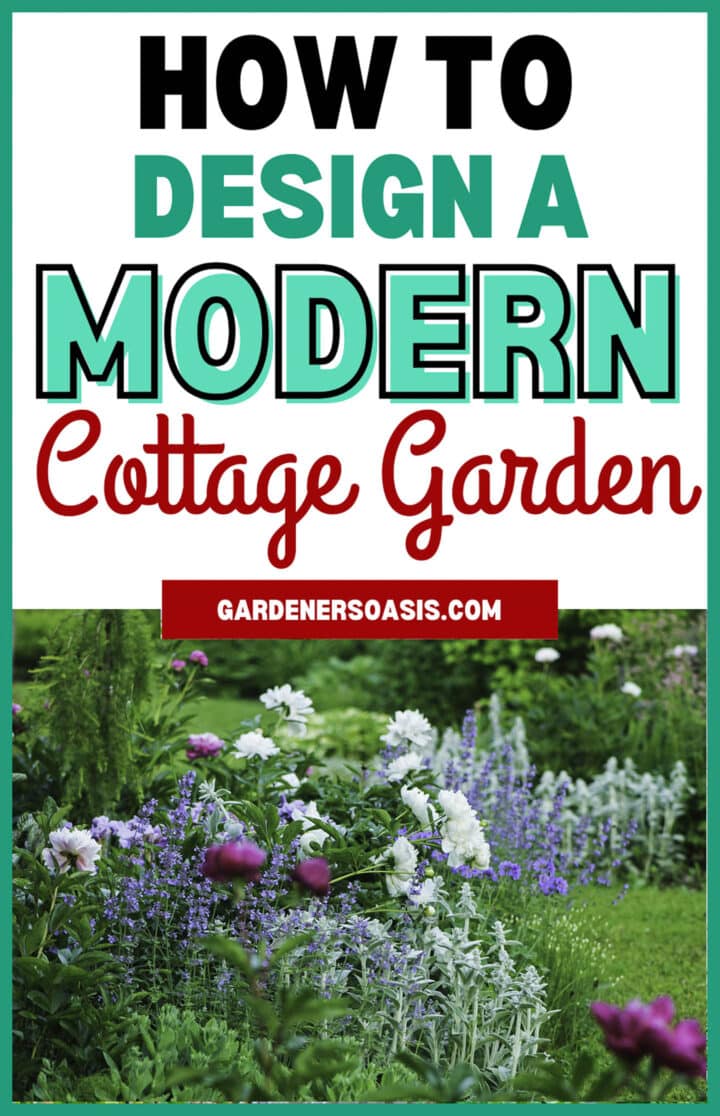
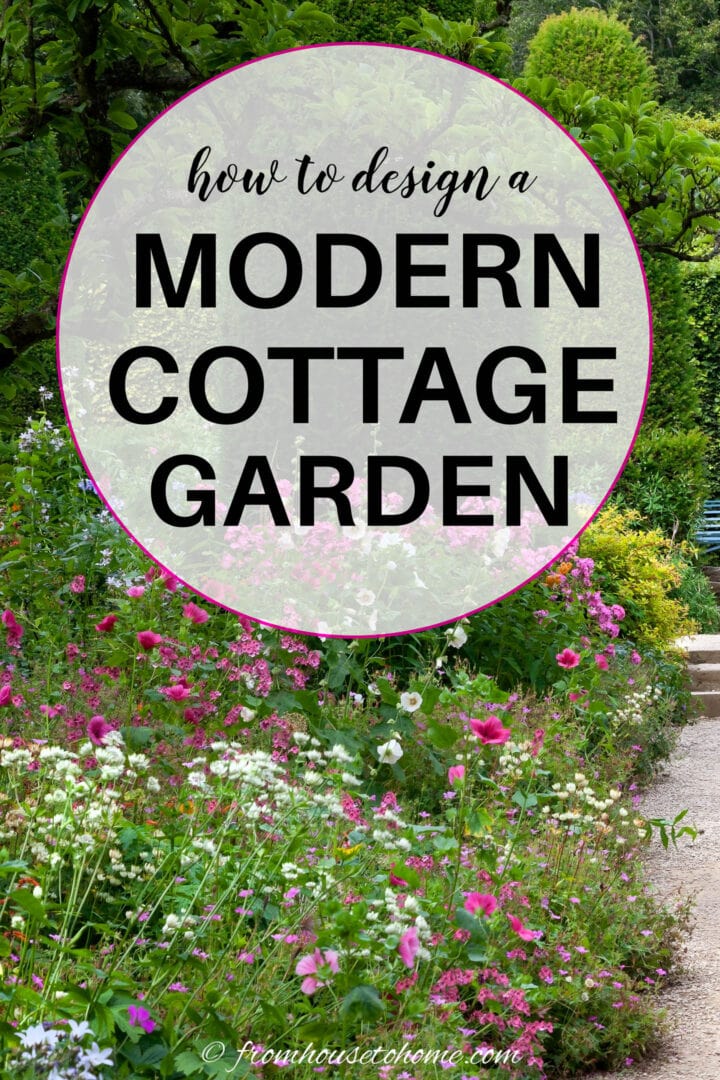
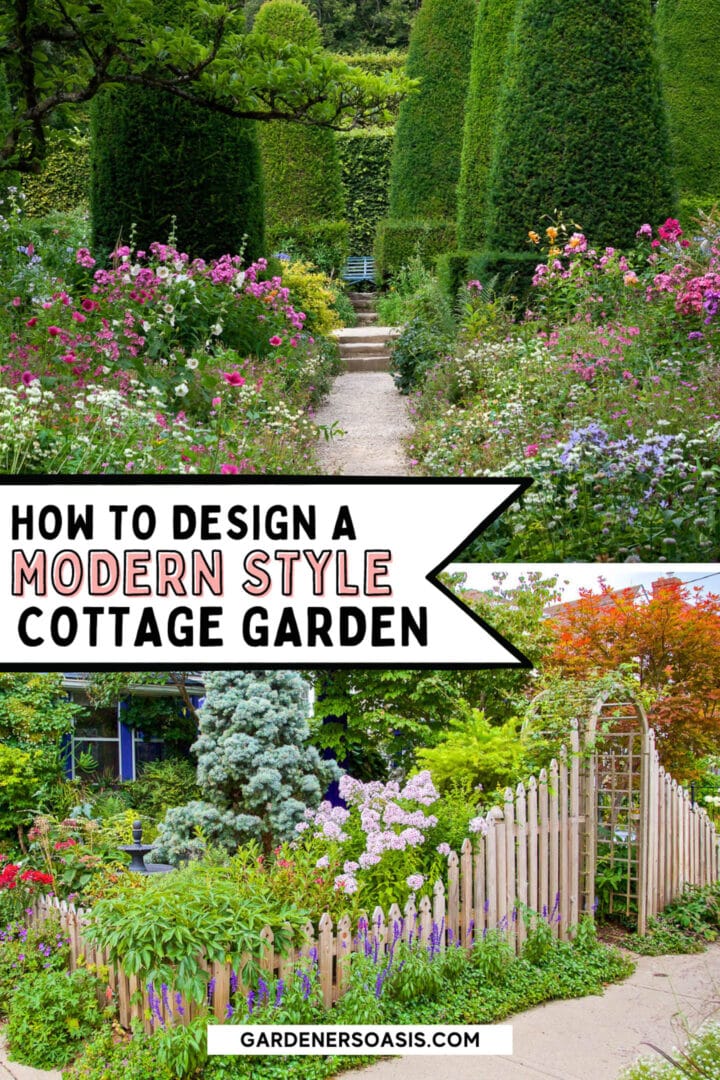
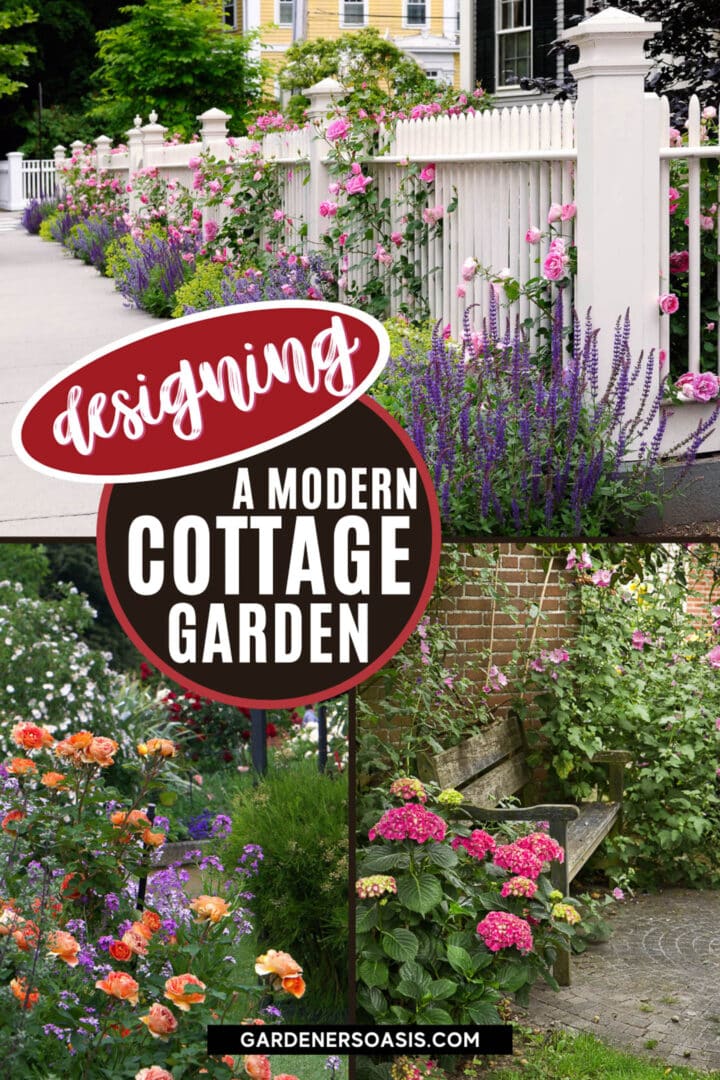
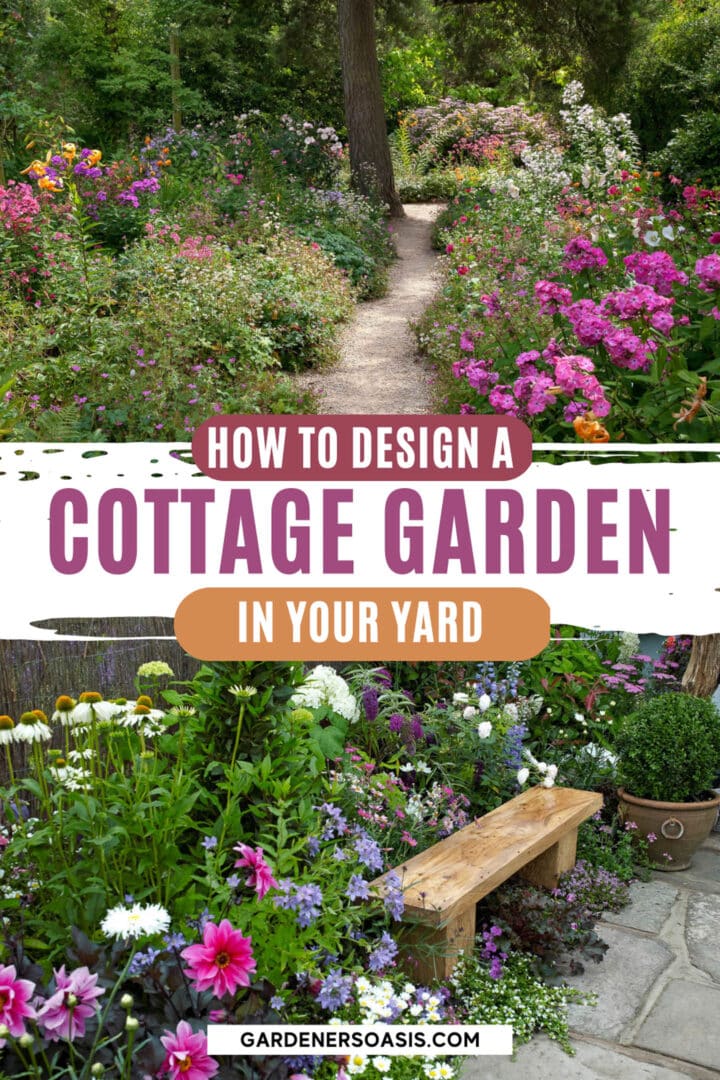
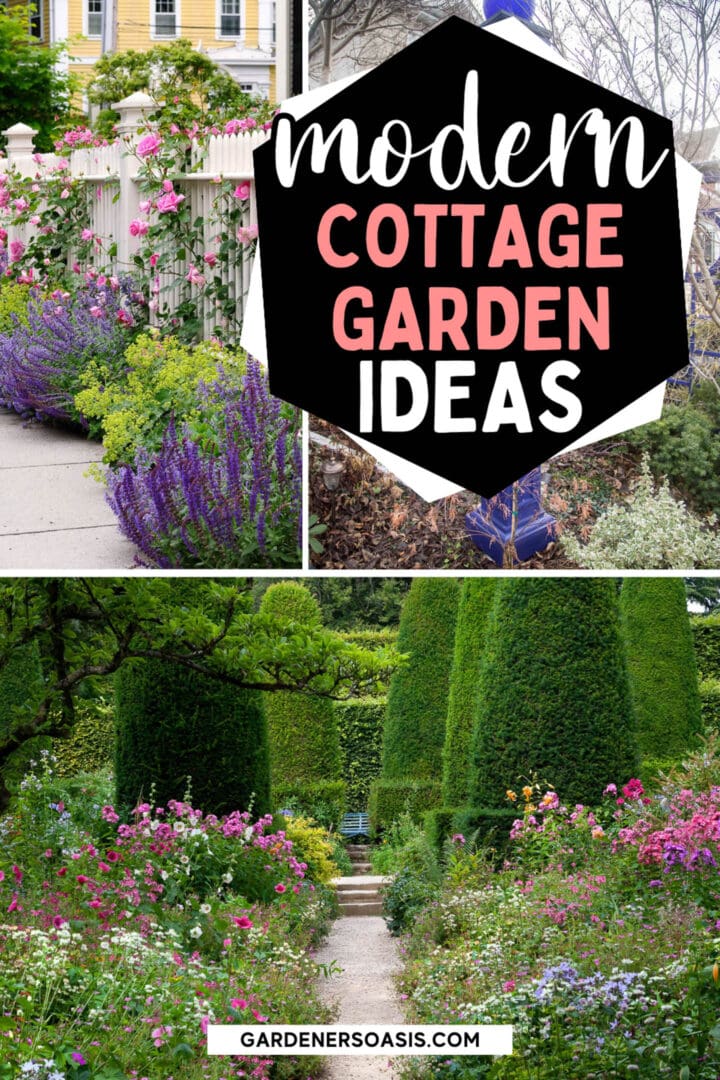
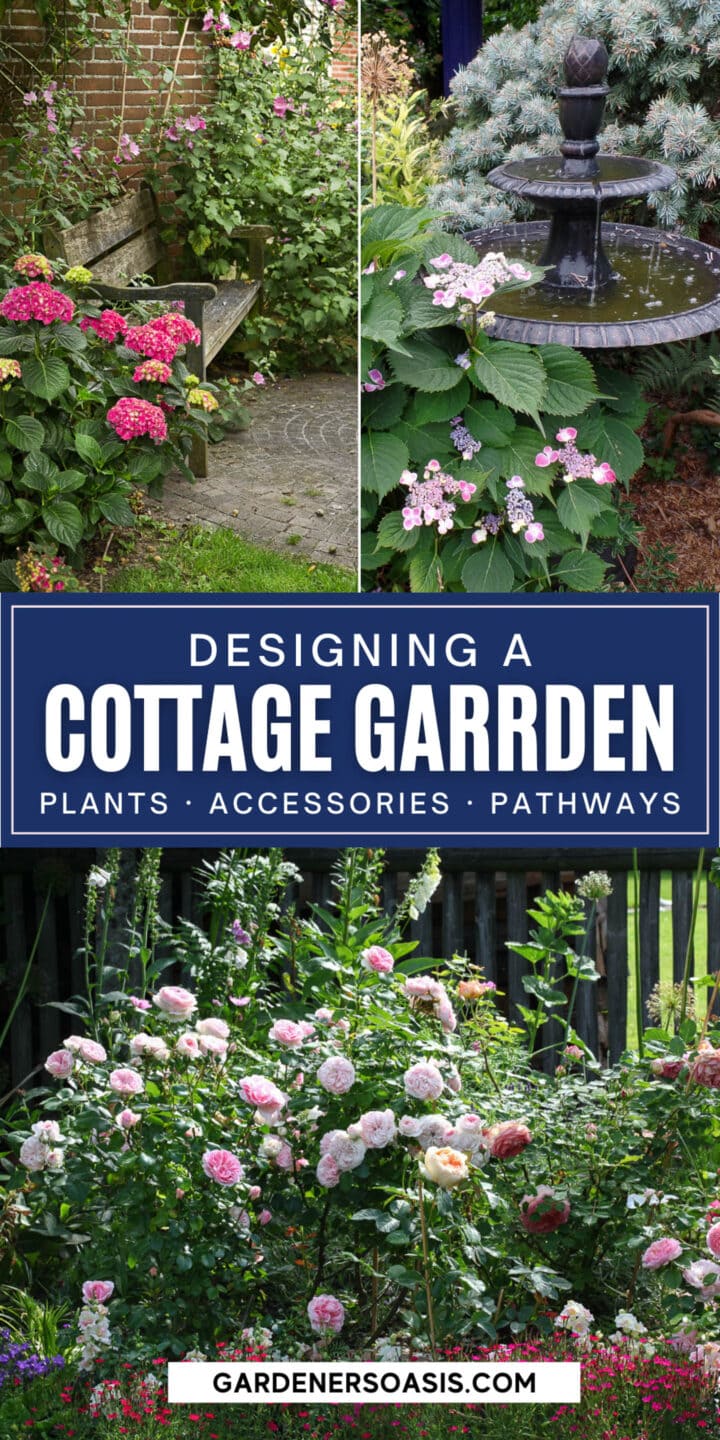
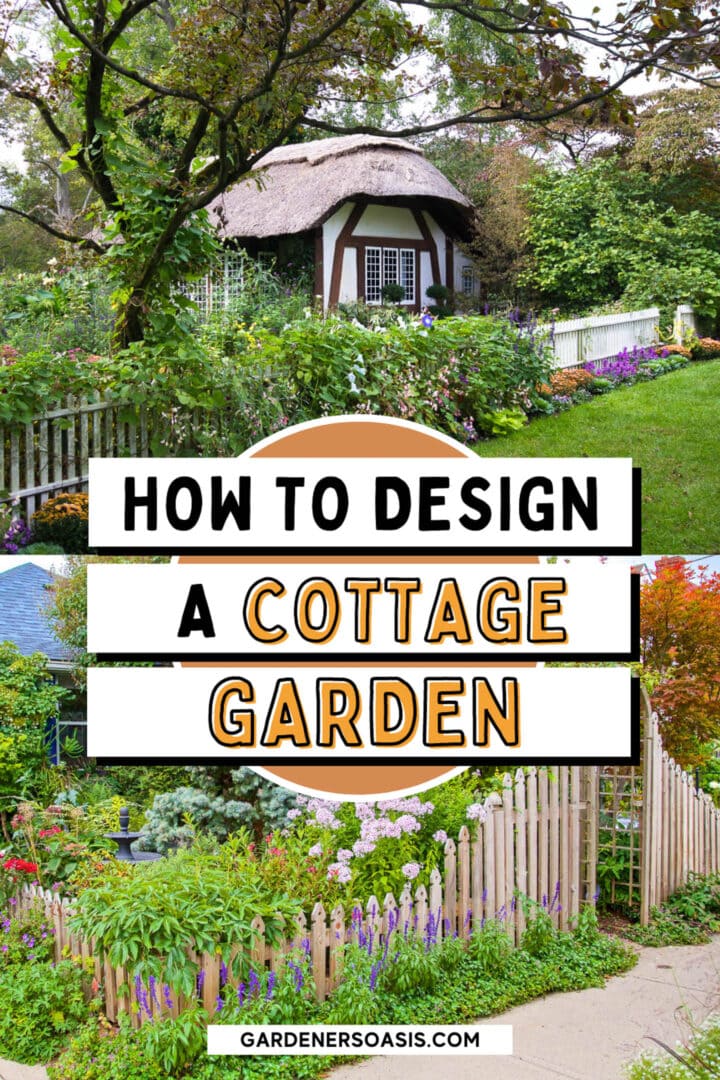
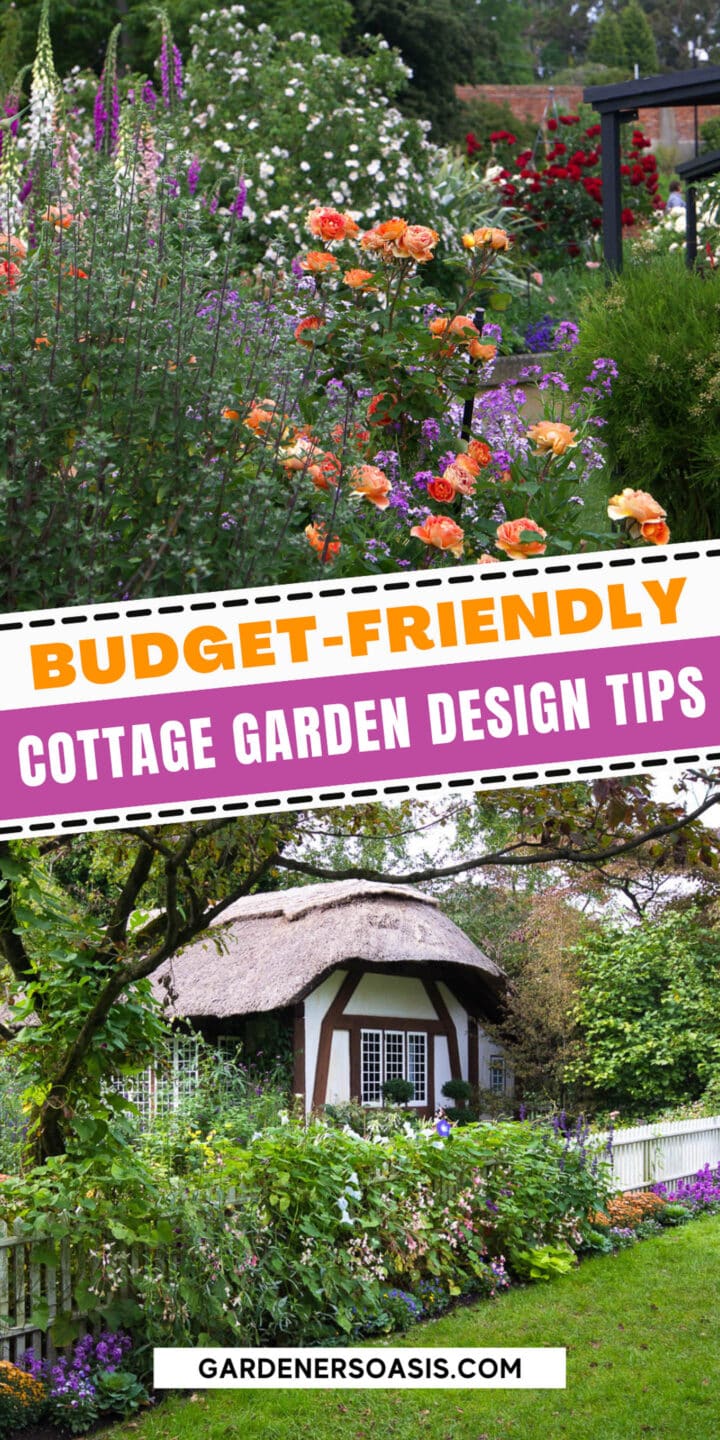
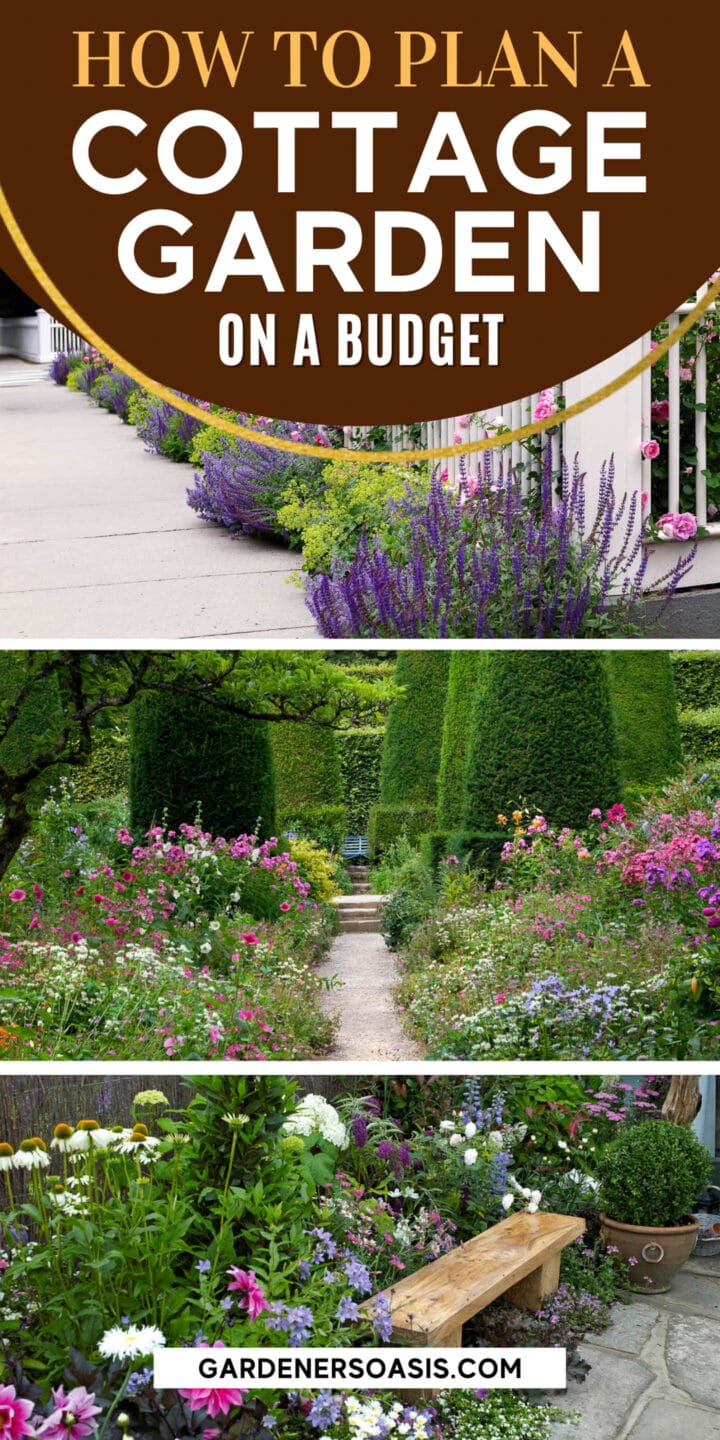
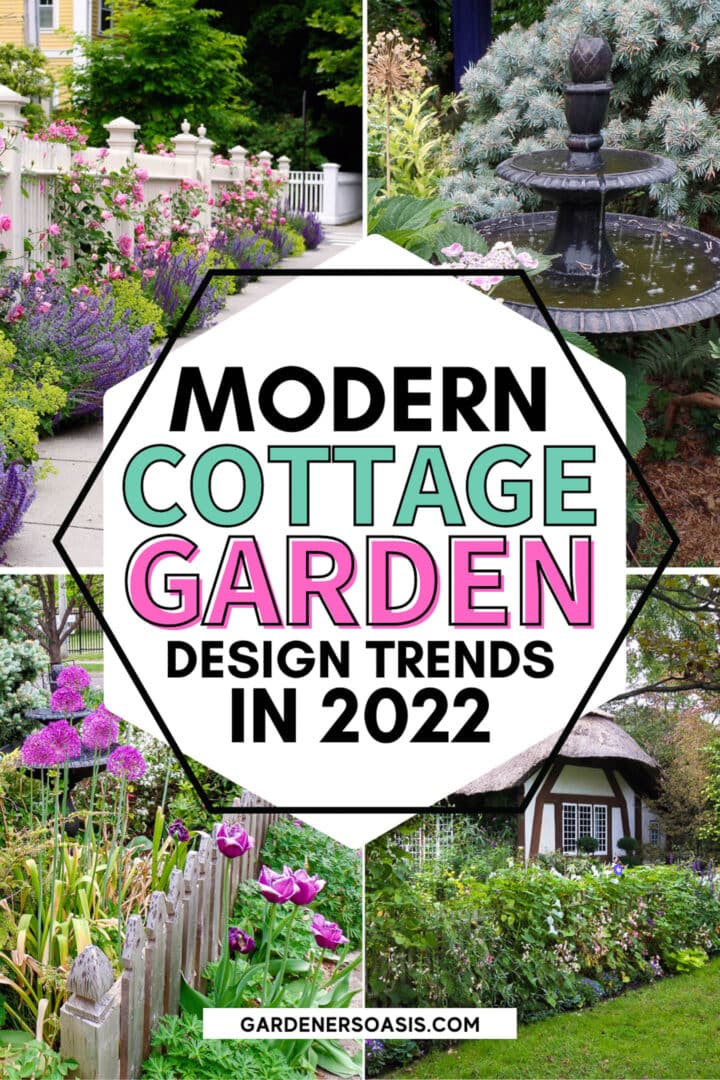
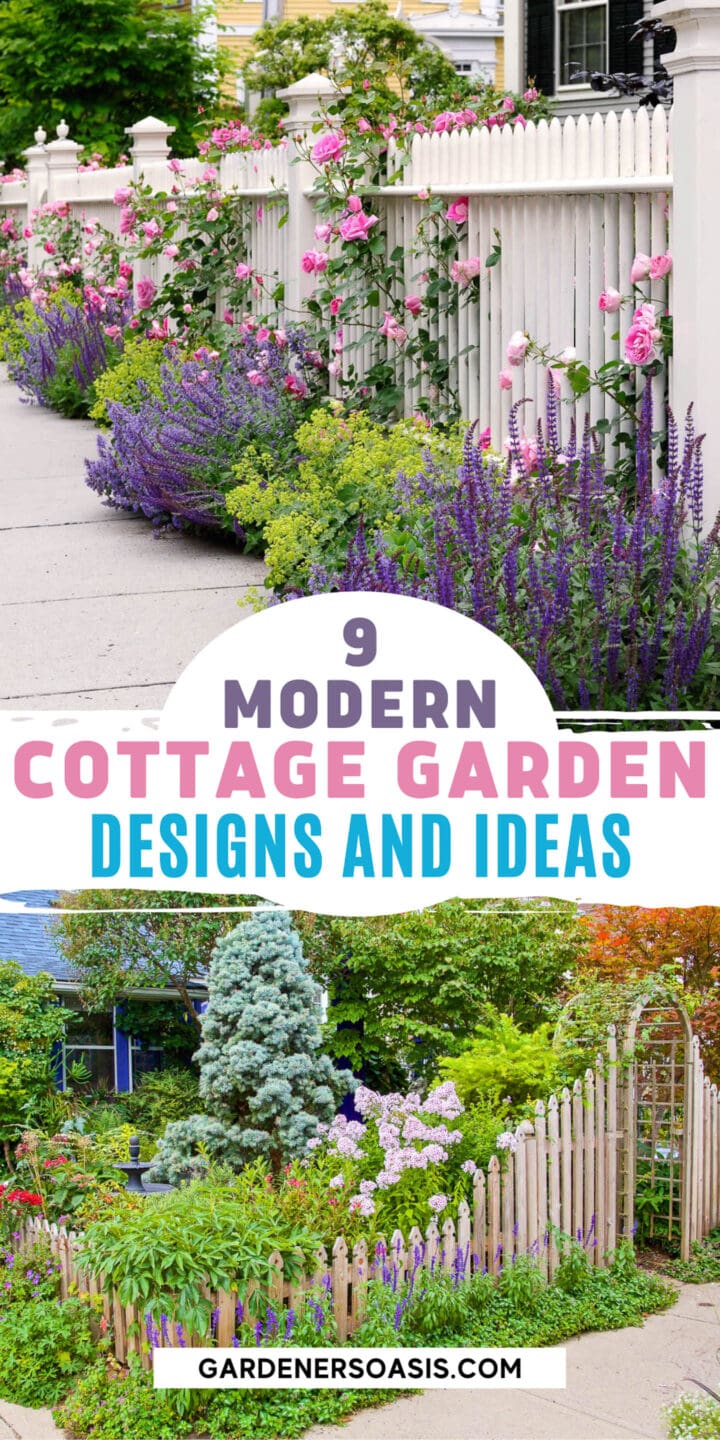
While I love seeing a variety of colors and textures, many of the modern cottage gardens shown seem overgrown and messy to me. I have an area with a white picket fence, pink double roses, lavender, and low growing lime green succulents in my backyard, I think any more of the ‘cottage look’ would look contrived.
The cottage garden look isn’t for everyone because it is a more haphazard style than some people like. Your white picket fence and garden sounds very pretty!
Your website is a fabulous site. Each subject is better than the last. I have an area in our eight acre property that I would like to do either a secret or cottage garden.
I have to consider deer. We came home the other night to find four deer in our garden to welcome us home. Thank you Wanda!!
Hello Judee, how exciting to plan for new garden space! One way to deter deer is to plant bushes on either side of the fence. Deer will not jump the fence if they cannot see the other side. You may be interested in our post about blooming hedges– you can find it here: “https://www.gardenersoasis.com/flowering-hedge-plants/”. Happy gardening.
I have several areas where I try to plant complimentary colors (planters on the patio) but my two cottage gardens are a riot of all colors, blooming all season long. In the end I believe that the creator meant all flowers (and people) in diversity and harmony.
Ruth Your gardens sound beautiful. Thanks for sharing.